Yes, poor attic ventilation can cause mold. When warm, moisture-laden air becomes trapped in an attic with inadequate airflow, it condenses on cooler surfaces like roof decking and rafters, creating the damp conditions mold needs to grow. Over time, this hidden moisture can quietly spread mold, weaken structural materials, and even affect the air quality inside your home.
Can poor attic ventilation cause mold? In the rest of the article, we’ll cover how attic ventilation works, why moisture builds up, the warning signs of mold, and practical solutions to improve airflow. You’ll also find prevention tips, maintenance best practices, and guidance on when to call a professional to protect your home from costly mold damage.
Attic ventilation is the system that allows fresh air to enter and stale, moisture-laden air to exit your attic. It typically works through a balance of intake vents (like soffit or eave vents) that bring in cool outside air and exhaust vents (such as ridge or roof vents) that let warm, humid air escape.
This steady airflow helps regulate temperature and control moisture in the attic. By keeping the space cooler and drier, proper ventilation protects your roof, insulation, and structural wood from damage, reduces the risk of mold, and improves your home’s overall energy efficiency.
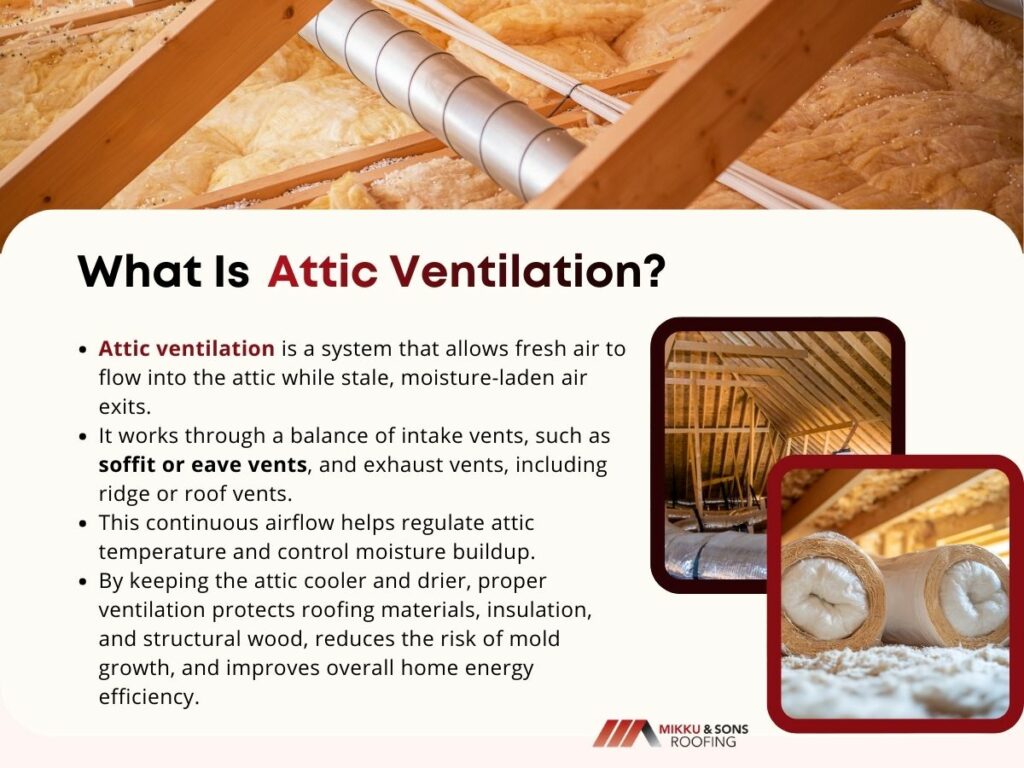
Poor attic ventilation traps heat and moisture, creating the perfect environment for mold to develop. Without proper airflow, damp conditions persist, allowing mold spores to settle, grow, and spread throughout the attic.
Everyday household activities release moisture that rises into the attic. When ventilation is inadequate, this moisture has nowhere to escape and becomes trapped, soaking into insulation and wood and creating ideal conditions for mold growth.
Warm, humid air in a poorly ventilated attic meets cooler roof surfaces and forms condensation. This repeated moisture buildup keeps rafters and roof decking damp, allowing mold colonies to take hold and expand.
Without proper ventilation, heat becomes trapped in the attic, especially during colder months. This leads to uneven temperatures that can cause snow on the roof to melt and refreeze, forcing water into the attic and increasing moisture levels.
Moisture trapped in the attic can saturate insulation, reducing its ability to regulate temperature and humidity. Damp insulation not only loses efficiency but also becomes a breeding ground for mold and mildew.
Poor ventilation allows airborne contaminants, including mold spores, dust, and organic particles, to remain suspended in the attic. These particles settle on damp surfaces and provide the nutrients mold needs to grow.
When moisture lingers due to poor airflow, wooden beams, rafters, and roof sheathing begin to absorb water. Over time, this weakens the structure and encourages mold to grow deep within the materials.
Poor attic ventilation allows moisture, heat, and airborne particles to accumulate, creating the ideal environment for mold. By improving airflow and controlling humidity, homeowners can significantly reduce the risk of mold and protect the integrity of their homes.
Mold grows in attics because the space often traps moisture and warm air, especially when ventilation is poor. When these conditions combine, they create an ideal environment for mold to develop and spread.
When moisture, warmth, and organic materials combine in a poorly ventilated attic, mold can easily take hold. Controlling humidity and improving airflow are the best ways to stop mold before it starts.
Mold in the attic can often go unnoticed until it causes damage or affects indoor air quality. Recognizing the early warning signs can help you address the problem before it spreads and leads to costly repairs.
A persistent, stale, or earthy smell coming from the attic is often the first indication of mold. Even if you can’t see it, this odor signals moisture and potential mold growth behind walls or in hidden areas.
Black, green, or white spots on rafters, beams, or roof decking indicate mold colonies forming. These discolorations often appear where moisture has been trapped over time.
Wet, clumped, or discolored insulation shows that moisture is accumulating in the attic. Damp insulation not only reduces its effectiveness but also provides a breeding ground for mold.
Excessive moisture in the attic can cause metal components to rust or corrode. Rusty nails, brackets, or HVAC components can be a sign of long-term humidity problems that support mold growth.
Stains, discoloration, or watermarks on ceilings or upper walls may indicate leaks or condensation from the attic. These signs often accompany mold growth in the underlying structure.
Increased allergies, coughing, sneezing, or respiratory irritation in household members can signal airborne mold spores from the attic. While not definitive, these symptoms combined with other signs suggest a mold problem.
Identifying these signs early can prevent mold from spreading and causing structural or health issues. If any of these indicators appear, inspecting your attic or contacting a professional is crucial to address the problem promptly.
Fixing poor attic ventilation is essential for controlling moisture, preventing mold, and protecting your roof. A well-ventilated attic allows fresh air to enter and stale, humid air to escape, keeping the space dry and balanced.
Soffit vents allow cool, fresh air to enter the attic from the eaves. If they are missing or blocked, adding or clearing them will greatly improve airflow and reduce moisture buildup.
Ridge and roof vents allow warm, moist air to escape from the top of the attic. When paired properly with intake vents, they create continuous airflow that helps regulate temperature and humidity.
Gaps around light fixtures, attic hatches, and ductwork allow moist indoor air to rise into the attic. Sealing these openings keeps humidity from entering and reduces the strain on your ventilation system.
Insulation should never cover soffit vents, as this prevents fresh air from entering. Using baffles or vent chutes helps keep air pathways open while maintaining proper insulation coverage.
Powered or solar attic fans can help remove excess heat and moisture when natural airflow is not enough. They work best when there is adequate intake ventilation to replace the air being exhausted.
Improving attic ventilation requires a balance of fresh air intake, proper exhaust, and sealed air leaks. When these elements work together, your attic stays dry, energy-efficient, and protected from mold and moisture damage.
Good attic ventilation keeps moisture under control, protects your roof, and helps prevent mold. These simple tips can improve airflow and keep your attic in a healthier condition.
Following these tips will help your attic stay dry, cool, and well-ventilated. Consistent maintenance and proper airflow are key to preventing mold and long-term structural damage.
While proper ventilation is essential, other strategies can further reduce the risk of mold and moisture damage in your attic. Combining these measures with good airflow helps create a healthier, longer-lasting home environment.
Leaky ducts can release warm, humid air into the attic, increasing moisture levels. Sealing these leaks ensures that conditioned air stays in your living spaces and prevents excess humidity from building in the attic.
Vapor barriers installed in the attic or between living spaces can block moisture from rising into the attic. This helps reduce condensation on roof surfaces and keeps insulation dry.
Ensure all vents from bathrooms, kitchens, and laundry rooms exhaust directly outside instead of into the attic. This prevents unnecessary moisture from entering the attic space.
Even small leaks can introduce significant moisture and encourage mold growth. Regularly inspect the roof and repair damaged shingles, flashing, or gutters to keep water out.
Properly installed and dry insulation regulates temperature and reduces condensation. Replace wet or compressed insulation to maintain effectiveness and prevent mold from developing.
Preventing mold in the attic goes beyond ventilation alone. By controlling moisture sources, sealing leaks, and maintaining insulation, you can significantly reduce the risk of mold and protect your home’s structure and indoor air quality.
Yes, poor attic ventilation can cause mold. Trapped heat and moisture create the ideal environment for mold to develop, which can damage wood, insulation, and roofing materials while also affecting the air quality in your home. Recognizing the signs early and understanding the risks is essential for protecting your attic and living spaces.
Addressing poor ventilation through proper airflow, sealing leaks, and maintaining insulation, combined with other moisture-control measures, can effectively prevent mold growth. Regular inspections and maintenance ensure your attic remains dry, healthy, and structurally sound, safeguarding your home from long-term damage.
Dark streaks on a roof show up slowly, then one day they’re all you can see from the street. At that point, pressure washing starts to sound like a quick fix as it works wonders on driveways and sidewalks.
A roof, though, is built in layers, designed to shed water, not take a direct hit from it. Is Pressure Washing a Roof Bad?High-pressure spray removes surface growth, but it can strip protective granules, force water beneath shingles, and loosen materials that were never meant to be pushed from below.
Is Pressure washing a roof bad? Pressure washing promises instant results, and that can be tempting when time is tight or curb appeal feels urgent. The roof may look cleaner in a single afternoon, but that clean look can come at a cost that shows up later as leaks, repairs, or a roof that suddenly seems to age faster than it should.
At a glance, a roof looks solid and fixed in place, built to take on years of sun, rain, and wind without much complaint. However, roofing systems rely more on careful layering and surface protection than brute strength.
Water is meant to flow across the surface and move away quickly. When water arrives with force and direction it was never designed to handle, the behavior of the materials changes in subtle but important ways.
Pressure washing introduces energy that roofing materials do not normally face. Instead of gravity guiding water downward, the spray pushes laterally and upward, which alters how surfaces respond.
That force does not spread evenly. Concentrated streams strike small areas with enough impact to disturb materials that appear stable from the ground, especially along edges, overlaps, and seams.
On asphalt shingles, pressurized water can dislodge protective granules that shield the underlying asphalt from sunlight. Those granules do not grow back, and once they wash away, the exposed surface absorbs more heat and wears faster.
A roof succeeds because water stays on the outside. Pressure washing changes that balance by pushing moisture against laps, joints, and penetrations with enough strength to bypass natural barriers.
Once water slips beneath the surface, it follows paths that are hard to predict. Gravity no longer works in your favor once moisture reaches the underlayment or decking.
Insulation can absorb moisture unnoticed, wood can swell or soften, and fasteners can begin to corrode. By the time stains or leaks appear, the original cause often feels disconnected from the damage, which makes diagnosis harder and repairs more extensive.
The effects of high-pressure cleaning rarely look dramatic right away. A roof can appear cleaner and intact while small failures begin beneath the surface.
Those early changes tend to blend in with normal wear, which allows problems to progress without drawing attention. Granule loss can look like routine aging and lifted shingle edges may settle back into place after drying, even though their seal weakens.
Minor shifts in flashing may not show until heavy rain tests the system. Pressure washing does not always break a roof in a single moment, but it can shorten the margin of safety that keeps everything working as intended.
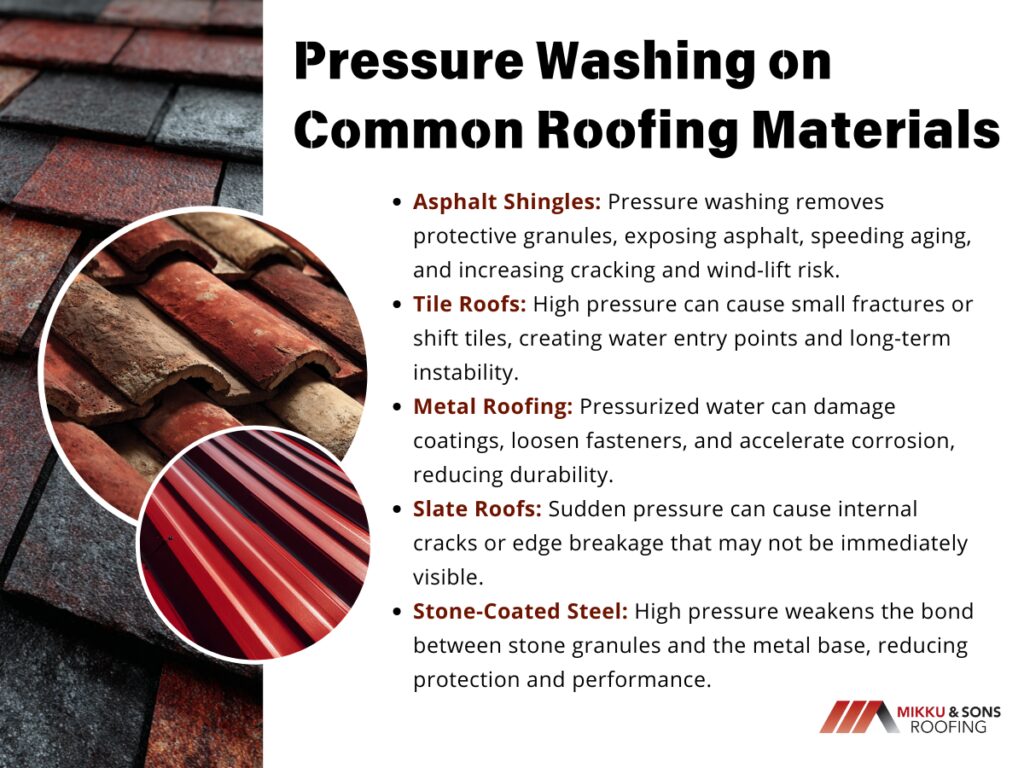
Roofing materials share a common purpose, but they behave very differently under stress. Each system relies on its own method of protection, attachment, and water control.
What works for one surface can create problems for another, especially when force replaces passive water flow. Some materials show damage quickly, while others hide it until weather and time expose weak points.
Asphalt shingles depend heavily on their outer layer to perform correctly. That top layer shields the asphalt core from heat and sunlight, which helps regulate aging and flexibility.
High-pressure spray can remove this protective layer unevenly. Granules wash away faster in some areas than others, which creates patchy exposure across the roof surface.
Once exposed, the asphalt beneath hardens more quickly, loses flexibility, and becomes more prone to cracking. Adhesive strips that help shingles stay sealed can also weaken, which increases the chance of wind lift.
Tile roofs appear rigid and substantial, but they rely on precise placement and balance rather than strength alone. Each tile rests in position as part of a larger system designed to shed water through overlap.
Pressure washing can introduce stress where tiles were never meant to flex. Small fractures can form without visible breakage, especially along edges and corners.
Individual tiles may shift slightly, which opens pathways for water beneath the surface. Once alignment changes, surrounding tiles can lose support, increasing the risk of broader issues over time.
Metal roofs handle weather well when their protective finishes remain intact. These coatings prevent corrosion and help regulate heat absorption across the surface.
Pressurized water can strip or thin those finishes, particularly along seams and fastener lines. Exposed metal reacts more quickly to moisture and air, which raises the chance of corrosion.
Fasteners may loosen under repeated force, and sealants around penetrations can degrade faster. The roof may still look sound, but its ability to resist water and temperature changes can decline.
Slate is dense and long-lasting, but it does not tolerate sudden impact or flexing. Each piece relies on its natural strength and precise placement to function correctly.
Pressure washing can introduce localized stress that leads to cracking or edge breakage. Damage may not appear immediately, as slate can fracture internally before visible failure occurs.
Once a slate breaks or shifts, surrounding pieces can lose support.
Stone-coated roofing combines a metal base with an adhered stone surface. That layered design depends on strong bonding between materials to remain effective.
Pressurized water can weaken that bond over time. Stone granules may release unevenly, and the underlying coating can wear away faster than intended.
As layers separate, the roof loses both protection and uniform performance.
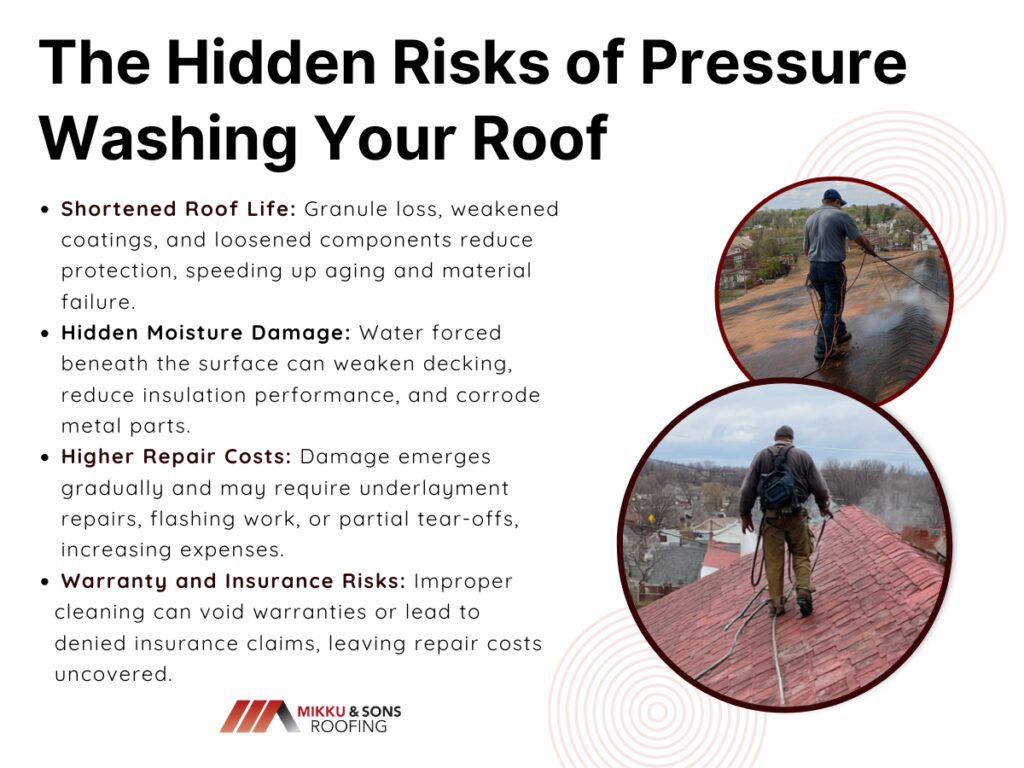
Immediate results can create a sense of reassurance. A clean surface suggests progress, and the roof may appear refreshed from the street.
That visual change can mask deeper shifts that take place beneath the surface layers. Small disruptions caused by force tend to compound as weather cycles repeat, which allows minor issues to evolve into larger structural concerns.
Roofing systems rely on surface integrity to manage heat, moisture, and movement. When that surface loses consistency, the materials beneath work harder to perform the same function.
Granule loss, weakened coatings, and loosened components all reduce the margin that protects the roof from daily exposure. As that margin narrows, aging accelerates.
Shingles may stiffen sooner, sealants can fail earlier, and protective finishes can wear away at a faster pace than expected.
Moisture does not need a visible leak to cause harm. Small amounts that enter beneath the surface can linger, especially in shaded or insulated areas.
Wood decking can absorb that moisture and lose strength over time. Insulation may compress or lose effectiveness, which affects temperature control inside the building.
Metal components can corrode quietly, weakening connections long before rust becomes visible.
Damage related to pressure washing rarely points back to a single event. Problems surface gradually, which complicates inspection and diagnosis.
Repairs often involve more than surface fixes. Sections of underlayment may require replacement, flashing may need adjustment, and compromised materials can demand partial tear-offs.
Costs tend to rise because the original source of damage blends into normal wear, which delays corrective action.
Roof warranties and insurance policies rely on proper care and approved maintenance methods. Cleaning practices that fall outside those guidelines can shift responsibility.
Claims may face challenges when damage traces back to improper pressure use. Manufacturers and insurers can view that damage as avoidable, which leaves repair costs uncovered.
What began as routine maintenance can turn into an expense that offers no protection or recourse.
A roof stays in good condition when cleaning supports its original design. The safest methods focus on removing buildup without disturbing surface protection or forcing water where it does not belong.
Gentle cleaning methods address the root of discoloration and organic growth instead of relying on impact. This approach reduces risk across all roofing types and preserves the systems that keep water moving in the right direction.
Soft washing uses low water pressure combined with cleaning solutions to treat organic growth and stains.
The approach avoids mechanical stress and preserves the roof’s layers and coatings.
Specialized chemical cleaners focus on removing biological buildup without harming roofing materials.
They neutralize contaminants and work with water to create a safer cleaning process.
Localized growth often appears in valleys, shaded areas, or sections near overhanging branches.
Manual methods allow precise control and minimize risk to surrounding materials.
Rinsing is essential to complete the cleaning process, but it must follow the slope and natural drainage patterns of the roof.
Controlled water flow maintains the integrity of the system.
Cleaning a roof safely affects how well your roof continues to protect the space beneath it. When you maintain the surface carefully, you reduce the chance of leaks developing, and that can save a lot of stress and expense later.
A roof that stays intact with its layers and coatings preserved keeps water where it belongs, instead of letting it seep inside and cause damage. Leaks that reach the interior often reveal themselves through stains, damp insulation, or warped materials.
Addressing a roof from the outside with gentle cleaning methods helps prevent these issues before they ever appear indoors. At the same time, knowing how to fix a leaking roof from the inside gives you a backup plan if water manages to get through.
Fixing a leaking roof from the inside can be a temporary but crucial solution, especially during heavy rain or when immediate outside access is unsafe. The most effective way to stop a roof leak from the inside is to contain the water, locate the source, and apply a temporary patch using roofing tar or a rubber sealant. This internal approach won’t permanently fix the issue, but it can prevent water damage until proper exterior repairs are made.
Below, we’ll walk through step-by-step instructions on how to fix a leaking roof from the inside. It also includes materials you'll need, safety tips, and how to know when it's time to call a professional roofer. You’ll also learn the signs of roof leaks, common causes, and how to prevent them in the future.
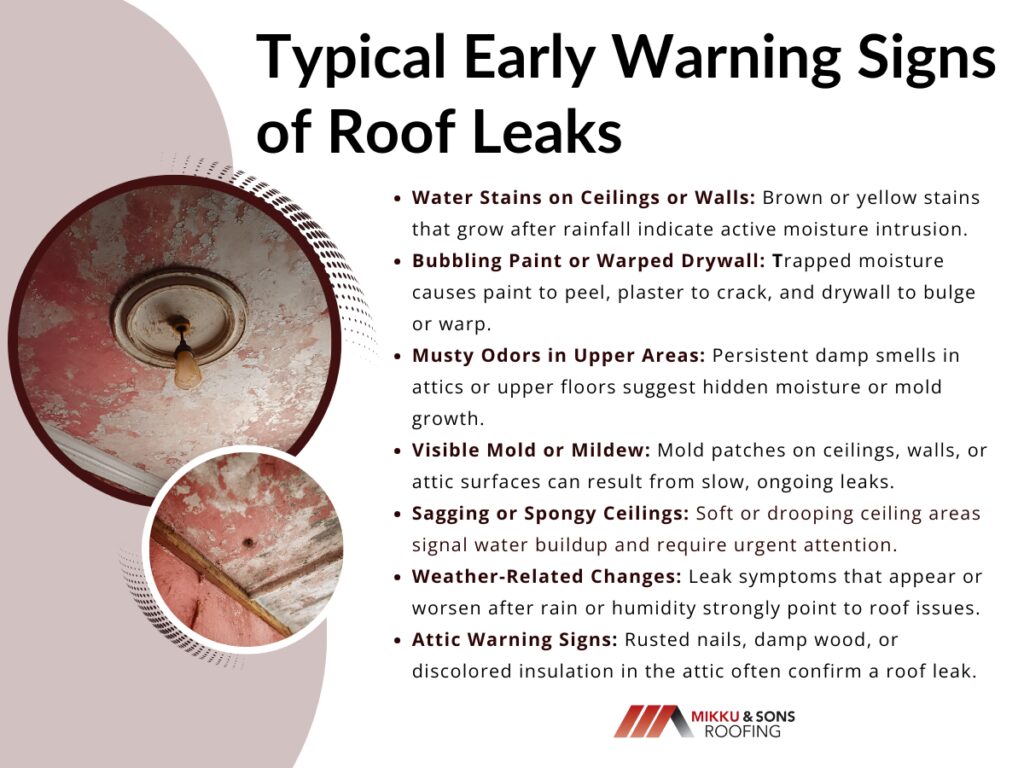
A leaking roof doesn’t always begin with a dramatic water drip. Many leaks develop gradually, and by the time water starts pouring through the ceiling, underlying damage may already be extensive. Recognizing the early signs of a roof leak gives you a critical opportunity to stop the problem before it spreads.
Here’s a breakdown of common symptoms to watch for some obvious, some subtle, but all potentially linked to moisture intrusion from above.
Perhaps the most well-known sign of a leak is the appearance of brown, yellow, or copper-toned stains on the ceiling or high on your walls. These irregularly shaped blotches often expand slowly over time, especially after heavy rainfall or snowmelt.
You may see a halo effect as moisture continues to seep into the drywall. Water stains can appear far from the actual leak because water travels along rafters or insulation before showing itself. A water stain that darkens after each storm is a strong indicator that the leak is still active.
Moisture trapped behind walls or ceilings often causes materials to warp, swell, or separate. You might notice paint that peels or bubbles along the ceiling line, or drywall that bulges outward slightly.
In older homes with plaster finishes, leaking water can lead to cracks or chipping, especially around corners and window trim. If your ceiling looks uneven or patchy, don’t ignore it moisture may be building up behind the surface.
Sometimes the first clue of a leak is something you smell. A persistent musty or earthy odor in your attic or upper-story hallway often signals mold or mildew growth. Even if you can’t see mold yet, the smell indicates lingering moisture possibly from a roof leak.
If the odor intensifies after a rainstorm or you’ve ruled out plumbing issues, it’s time to investigate the attic space for signs of wet wood or insulation.
Small mold patches on ceilings, walls, or attic surfaces can develop quickly in the presence of a slow leak. You might spot dark black spots, white powdery growth, or green blotches near roof vents, chimneys, or bathroom ceilings.
Even if mold appears far from the roofline, water could have traveled through framing or ductwork. Any indoor mold should be taken seriously, especially when combined with other leak symptoms.
If a portion of your ceiling feels soft when touched or visibly sags, there’s likely water pooling behind it. In severe cases, these areas may droop or bubble outward, forming a bulge in the drywall or plaster.
This can be dangerous not only structurally but also because of the risk of a sudden ceiling collapse. You may also notice drywall seams cracking or tape pulling away.
At this stage, the leak has likely been active for some time and needs urgent attention.
Do stains seem to grow after every storm? Does a smell return only during humid days? When signs of moisture appear, disappear, and reappear based on rain or outdoor temperature, that strongly points to a roof-related issue.
Some leaks may only be visible during wind-driven rain or after snow starts melting on the roof. Tracking the timing of these signs helps pinpoint the source and confirms that the roof is the likely entry point.
If you have attic access, use a flashlight to look at the rafters and underside of the roof deck. You may see rust around nails, damp wood, or dark trails that suggest water flow. Mold or mildew in insulation can also show up here before making its way into finished spaces.
Your attic can reveal clues before they show on interior ceilings, especially if the leak is small or seasonal.
Finding water dripping from your ceiling is stressful but staying calm and taking the right first steps can make a big difference. Your immediate goal should be to contain the leak and prevent further damage to your home’s interior.
As soon as you notice the leak, place a bucket or deep container directly underneath the drip to catch the water. If splashing becomes an issue, place a towel inside the bucket or lay a wooden board across the top to minimize noise and water spread.
Protect nearby furniture, rugs, and flooring by laying down plastic sheeting or absorbent towels. Move any electronics or valuables away from the area. It’s also wise to keep a mop or additional towels nearby in case the leak spreads.
If water is pooling above the ceiling drywall, you might see a swollen or bulging area forming. This is a warning sign of a heavy water pocket that could collapse suddenly. Use a screwdriver or utility knife to puncture the lowest point of the bulge and let the water drain in a controlled stream.
Be sure to have a bucket in place underneath before puncturing. While it might seem risky to poke a hole in your ceiling, controlled drainage is safer than waiting for a ceiling collapse.
After the immediate mess is under control, you can begin diagnosing the source of the leak and preparing for temporary or permanent repairs.
Tracking down the exact source of a roof leak is often harder than it sounds. Water doesn’t always drip straight down it can follow beams, wires, or insulation for several feet before emerging through your ceiling. That’s why the visible leak is rarely directly under the entry point on your roof.
If it’s safe to do so, inspect your attic during the rain or shortly afterward. Bring a bright flashlight and wear protective clothing, especially if insulation is involved.
Look for:
If you see a wet area on insulation, peel it back and follow the trail up the rafter or decking until it disappears. The highest visible wet point is typically closest to the actual roof entry.
For homes with heavy insulation or no attic access, locating the leak becomes trickier. In those cases, you may need to rely on a moisture meter or consult a roofing professional who can assess the situation more thoroughly from outside.
Once you've located the leak, it's time to gather the right tools for a temporary patch. Keep in mind this is a stopgap measure you'll still need to make permanent exterior repairs when the weather allows.
Here’s what you should have on hand:
Choose products labeled for wet application and waterproof sealing. Many hardware stores carry emergency leak patch kits that are ideal for quick indoor fixes.
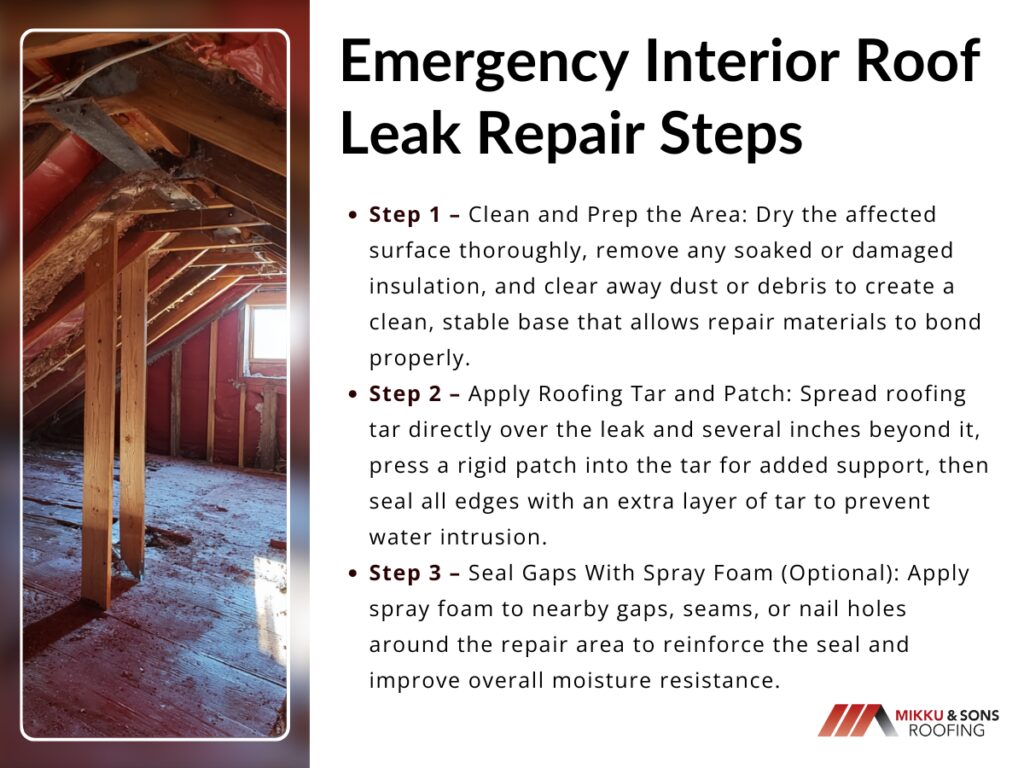
A successful interior roof patch requires careful application of materials and a clean, stable working area. Follow these steps to apply a temporary patch that can hold until a roofer makes a full exterior repair.
Use a cloth, sponge, or paper towels to dry the surrounding surface as much as possible. If insulation is soaked, remove it carefully and set it aside for later replacement.
Clearing debris and drying the wood gives your patch materials a better chance of adhering securely. Avoid using a heat source like a hairdryer in the attic it can be a fire hazard near insulation.
Use your putty knife to spread roofing tar directly over the leak point, pressing it into cracks or seams in the wood. Cover a radius of at least 6 to 8 inches around the leak to ensure a tight seal.
Next, press a piece of shingle, plywood, or metal patch over the tarred area. This gives structure to the patch and prevents further tearing or sagging.
Apply another thick layer of tar around the edges of the patch to lock everything in place. Smooth it down to remove air bubbles and gaps.
If there are visible gaps, joints, or nail holes nearby, spray foam insulation can add an extra layer of protection. It expands into crevices and dries into a solid, water-resistant barrier.
Just be cautious not to overfill excess foam can push materials apart or make later repairs more difficult. Allow the foam and tar to fully cure according to the product instructions before replacing insulation or sealing the attic again.
Fixing a leaking roof from the inside is only a short-term solution. The real fix involves exterior repairs or full roof replacement, especially if leaks are frequent or your roof is aging.
For reliable results, plan for a full inspection once the weather clears. A professional roofer can check the shingles, flashing, underlayment, and deck for damage that’s not visible from inside.
In some climates, replacing a roof during dry months like fall or early spring ensures better sealing and fewer delays.
A foam roof seals gaps, adds insulation, and creates a single continuous surface without seams or fasteners. When it’s installed correctly and cared for, it handles heat, rain, and daily exposure better than many flat roofing systems.
But like anything exposed to the elements year after year, it doesn’t stay perfect on its own. Problems with foam roofs tend to start small, a thin spot in the coating or a low area where water lingers longer than it should.
Water does not drip straight down the way it does with traditional systems. It can move sideways beneath the surface, spreading quietly before there’s any visible sign inside the building. Let's look at various common foam roof problems and how to fix them.
Spray foam roofing does not follow the same rules as most flat roof systems. Instead of layered sheets or membranes laid over a surface, this system forms directly in place.
That difference affects how the roof seals, insulates, and reacts to movement across the structure. Because the material expands and bonds to what sits beneath it, the roof becomes a single surface rather than a collection of parts.
A foam roof forms as a continuous layer that adheres to the deck, flashing areas, and penetrations in one pass. That seamless nature removes many of the weak points found in traditional flat roofs, especially around joints and transitions.
With no seams to pull apart, water entry tends to occur only where the surface has been damaged or worn thin. This changes the inspection process, since attention shifts from lap lines and fasteners to coating condition and foam integrity.
Foam bonds directly to the substrate rather than resting on it and roof penetrations receive the same material as the field area. This means leaks usually trace back to surface damage instead of joint failure
Most flat roof systems separate insulation and waterproofing into different components. Spray foam combines both functions into a single layer, which changes how heat and moisture move through the roof assembly.
Because insulation sits at the top of the roof rather than below a membrane, temperature swings affect the structure differently. This setup can reduce thermal movement in the deck, but it also places greater importance on surface protection.
Closed-cell foam resists water absorption as thermal performance comes from the roof surface itself. The coating condition directly affects both insulation and water resistance
Foam roofs allow repairs without removing large sections of material. New foam can bond to existing foam, which makes localized fixes possible without disturbing the rest of the system.
This repair method differs from membrane roofs, where patches often rely on adhesives or mechanical attachment. With foam, the goal focuses on restoring thickness and surface protection rather than replacing sheets.
Damaged areas can be cut out and refoamed making repairs integrated into the original surface. Large tear-offs are less common when problems are caught early.
Water that remains on a roof longer than expected changes how the entire system behaves. Foam reacts differently than sheet-based flat roofs because the surface coating carries much of the protective role.
When water stays in place, it places constant stress on that outer layer rather than shedding off naturally. There may be no immediate leak, no visible damage inside the building, and no obvious failure at first glance but the presence of standing water begins to affect performance.
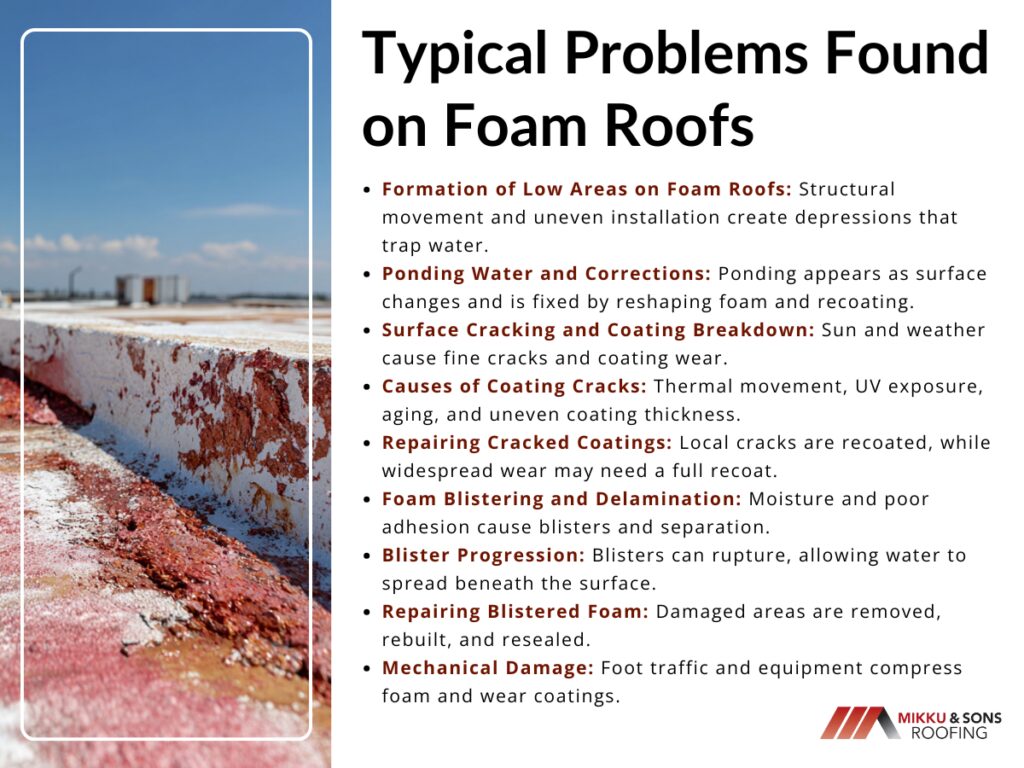
Roof surfaces rarely remain perfectly flat over their full lifespan. Minor shifts in the structure, compression at the deck, or inconsistencies during installation can create shallow depressions that hold water after rainfall.
These low areas do not always appear dramatic. Even a slight variation in slope can trap water long enough to stress the coating system and expose weaknesses that would otherwise stay dormant.
Uneven foam thickness during installation, structural deflection in older buildings and settling around drains or penetrations can cause low areas on foam roofs.
Early indicators often appear on the roof surface long before water reaches the interior. Subtle changes in texture or color can signal that water has overstayed its welcome.
The roof surface itself usually needs adjustment so water no longer collects in the same areas. Repairs often involve reshaping the foam, restoring proper slope, and applying fresh protective coatings.
Ponding water may seem harmless at first, but on a foam roof it often signals a problem that grows with time. Addressing it early helps protect the coating system, preserve insulation performance, and reduce the risk of larger repairs later on.
The surface of a foam roof takes the brunt of daily exposure. Heat, sunlight, and weather cycles all work against the coating that protects the foam beneath.
Over time, that constant exposure can show itself through small surface changes that are easy to overlook at first. These issues usually appear as fine cracks or worn areas that seem cosmetic.
Coatings expand and contract as temperatures rise and fall. Repeated movement, combined with aging materials, can lead to surface cracking, especially in areas that receive intense sunlight or experience wide temperature swings.
Application thickness also plays a role. Coatings applied too thin wear faster, while uneven coverage can create stress points that crack sooner than surrounding areas.
Daily thermal expansion and contraction, prolonged UV exposure and inconsistent coating thickness all cause coatings to crack over time.
Repairs focus on restoring the protective barrier rather than replacing the entire roof. Localized cracks often receive cleaning, sealing, and recoating to rebuild thickness and flexibility.
Widespread breakdown may call for a full recoat to reestablish uniform protection. Addressing cracks early can limit repairs to surface work and extend the service life of the foam system.
Surface cracking and coating breakdown serve as early warnings rather than sudden failures. Paying attention to these signs allows timely repairs that protect the foam beneath and keep larger problems from developing.
Blistering and separation occur when the bond between the foam, the substrate, or the coating begins to fail. Once that pressure has nowhere to go, it forces the material upward, creating raised areas that weaken the roof’s protective layer.
This type of damage often signals a deeper issue rather than surface wear alone. Trapped moisture, poor adhesion, or contaminated substrates usually sit at the root of the problem.
Once a blister forms, the surrounding area becomes more vulnerable. Movement from foot traffic or temperature shifts can cause the blister to rupture, allowing water direct access to the foam beneath.
Delamination occurs when the foam or coating loses adhesion across a wider area. At that point, water can travel beneath the surface rather than draining off, which accelerates deterioration beyond the original blister.
Raised or spongy areas underfoot often provide the first clue. In some cases, the coating may appear stretched or slightly discolored where separation has begun.
Repairs start with cutting out the affected section to expose the underlying condition. Any damp or loose material must be removed so new foam can bond properly.
After rebuilding the area with fresh foam, the surface receives a protective coating that ties the repair back into the surrounding roof. When moisture sources get addressed at the same time, these repairs tend to hold up well over the long term.
Foam roofs handle exposure well, but they do not respond the same way to repeated physical stress. Unlike hard membrane systems, foam can compress under weight, especially in areas that see regular movement or support equipment.
Over time, that compression changes the surface profile and weakens the protective coating. A single step rarely causes noticeable harm, but repeated pressure in the same locations creates wear patterns that eventually break through the coating and expose the foam.
Walking paths often form naturally between access points, HVAC units, and roof edges. When these paths lack added protection, the foam beneath the coating can compress and lose thickness.
As the foam compresses, the coating stretches and thins. That loss of uniform coverage makes the surface more prone to cracking and moisture entry.
Mechanical units place constant load on the roof surface. Vibration from fans or compressors adds stress that foam roofs do not absorb as well without reinforcement.
Designated walk pads and reinforced pathways help distribute weight and reduce surface wear. These additions protect the foam while allowing safe access for maintenance and inspections.
When traffic routes are planned and protected, the roof surface maintains its integrity longer and repair needs decrease. Mechanical damage often develops in predictable locations.
Managing traffic and equipment loads plays a key role in preserving foam roof performance and avoiding premature surface failure.
Sun exposure plays a major role in how long a foam roof lasts. The foam itself does not tolerate direct ultraviolet light, which is why a protective coating covers the surface from day one.
When that coating thins or wears away, the foam beneath begins to change. This type of deterioration progresses slowly, often without obvious signs until the foam surface starts to powder or erode.
Exposed foam reacts quickly to sunlight. The surface can discolor, become brittle, and lose density as ultraviolet rays break down the material.
Once erosion begins, water can cling to the roughened surface rather than draining away. This combination of moisture and sun exposure accelerates surface loss and increases the chance of leaks.
The coating serves as both a UV shield and a weather barrier. Areas with thin or uneven coverage wear faster, especially on roofs that receive full sun throughout the day.
Powdering, surface roughness, or visible foam color changes point to UV damage. These signs usually appear before leaks develop, which creates an opportunity for corrective work.
Repairs typically involve cleaning the affected surface, rebuilding lost foam where necessary, and applying a fresh protective coating. Restoring proper thickness returns the roof’s ability to resist sunlight and shed water.
Regular recoating remains one of the most effective ways to slow UV-related deterioration and preserve foam roof performance. UV exposure remains a constant factor for foam roofs. Maintaining the protective coating helps prevent surface erosion and keeps the system functioning as intended.
Foam roofs operate differently from traditional flat roofing systems, and the way they handle water, heat, and physical stress affects both performance and maintenance. Knowing the types of problems to watch for allows you to prioritize inspections and respond before small issues evolve into larger failures.
Comparing foam roofing to conventional systems emphasizes these differences. Unlike built-up, single-ply, or modified bitumen roofs, foam integrates insulation and waterproofing into one layer.
That integration changes where problems appear and how they are repaired. Issues that would normally show up at seams or fasteners in traditional roofs instead emerge on the foam surface, making coatings, thickness, and adhesion critical factors.
Roof emergencies place immediate strain on homeowners who face structural risks and urgent repair needs. Insurance delays increase anxiety because each hour of inaction exposes the property to further damage.
Insurance carriers process claims based on documentation, severity, and internal workload. Heavy storm seasons create backlogs that extend standard response times significantly.
Water intrusion, structural shifts, and electrical hazards escalate rapidly without immediate intervention during emergency roof failures. Insurance delays add complexity because temporary protection may require out-of-pocket expenses before reimbursement occurs. Let's look at dealing with insurance delays during roof emergencies.
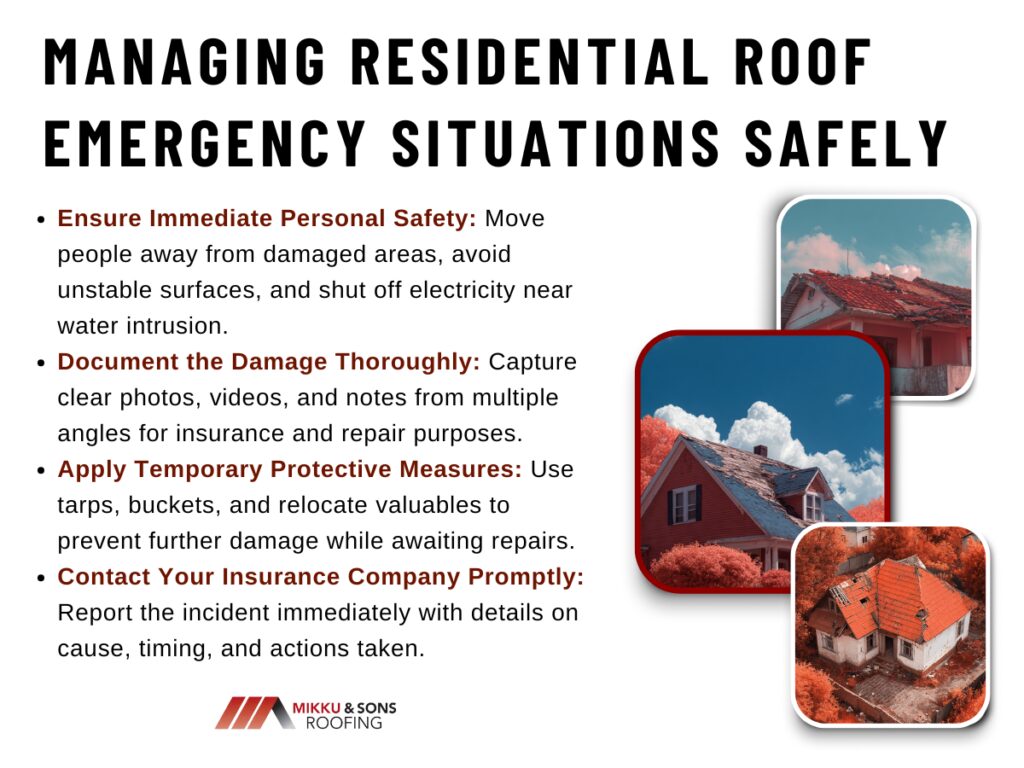
Roof emergencies demand immediate attention to prevent further damage and ensure family safety. Homeowners who respond quickly reduce repair costs and mitigate structural risks effectively.
Preparation and decisive action allow homeowners to maintain control during stressful situations. Early interventions also support insurance claims by providing clear evidence of the damage.
The first priority is to protect yourself, family members, and pets from hazards caused by damaged roofing. Fallen debris, unstable surfaces, and leaks create immediate risks that require careful navigation.
Move everyone to a secure area away from compromised sections of the home. Avoid walking on damaged roofing or attempting repairs without proper expertise and protective equipment.
Safety measures include:
These steps prevent injury while allowing later inspections or repairs to proceed safely. Clear identification of hazards also helps contractors and insurance adjusters assess damage efficiently.
Homeowners should capture detailed records of the damage immediately after ensuring safety. Photographs, videos, and written notes provide evidence for insurance claims and repair planning.
Include multiple angles, close-ups of damage, and contextual images showing the roof’s location. Annotate images with dates and descriptions to create an accurate and organized record.
Proper documentation accelerates claim approvals and reduces the risk of disputes. Insurers rely on clear, verifiable evidence to determine coverage and expedite inspections.
Temporary interventions stabilize the roof and prevent additional damage while waiting for professional repair. Only implement measures that maintain safety and do not worsen structural issues.
Avoid walking on damaged surfaces or attempting complex repairs without professional guidance. Temporary measures may involve:
These actions protect the home from escalating issues and minimize insurance claim complications. Timely temporary solutions demonstrate diligence to insurers and can influence claim approval speed.
Inform your insurance provider as soon as possible to initiate the claims process. Early reporting helps document the timeline of damage and ensures adjusters prioritize urgent situations.
Provide detailed information about the incident, current safety measures, and damage documentation. Insurers often guide next steps and advise on approved contractors or temporary repair allowances.
Include:
Prompt communication reduces delays and aligns the repair process with policy requirements. It also establishes a clear record that protects homeowners during claim evaluations.
Roof emergencies often expose gaps in homeowners’ understanding of their insurance coverage. Clear knowledge of policy terms, limits, and exclusions helps prevent surprises during urgent repairs.
Awareness of coverage scope allows homeowners to plan temporary measures, document damages effectively, and communicate confidently with insurers. Reviewing policies in advance reduces delays and ensures smoother claims.
Policies may provide different forms of coverage depending on damage type, age of the roof, and policy provisions. These distinctions clarify what repairs or replacements qualify for reimbursement.
Common coverage types include replacement cost, actual cash value, and limited roof insurance for older structures. Replacement cost policies pay for full repair or replacement without depreciation deductions, while actual cash value accounts for wear and tear.
Verify whether policies cover:
Correct classification of coverage prevents denied claims and supports faster approvals. Insurers often provide detailed explanations in policy documents or customer portals.
Exclusions define circumstances where coverage does not apply, often including roofs past a certain age or damage from lack of maintenance. Limits set the maximum payout for covered damages, which may differ between types of coverage or roof components.
Review limits on shingles, structural elements, and labor costs to estimate potential out-of-pocket expenses. Common exclusions may include roofs older than the policy’s specified age limit, damage caused by neglect or deferred maintenance and cosmetic or non-structural issues not affecting safety.
Deductibles influence the immediate cost homeowners must pay before insurance coverage applies. Higher deductibles reduce premiums but increase out-of-pocket expenses during emergencies.
Filing multiple claims in short periods may affect future premiums or eligibility for full coverage. Homeowners must weigh the urgency of repair against potential premium adjustments.
| Deductible Type | Typical Amount | Effect on Claim |
| Flat Deductible | $500–$2,000 | Homeowner pays this amount first; insurer covers remaining approved costs |
| Percentage Deductible | 1–5% of insured value | Deductible scales with home value; may increase out-of-pocket cost for large homes |
| No Deductible | $0 | Rare; insurer covers approved costs fully, may have higher premium |
Accurate knowledge reduces stress, speeds claim processing, and protects property.
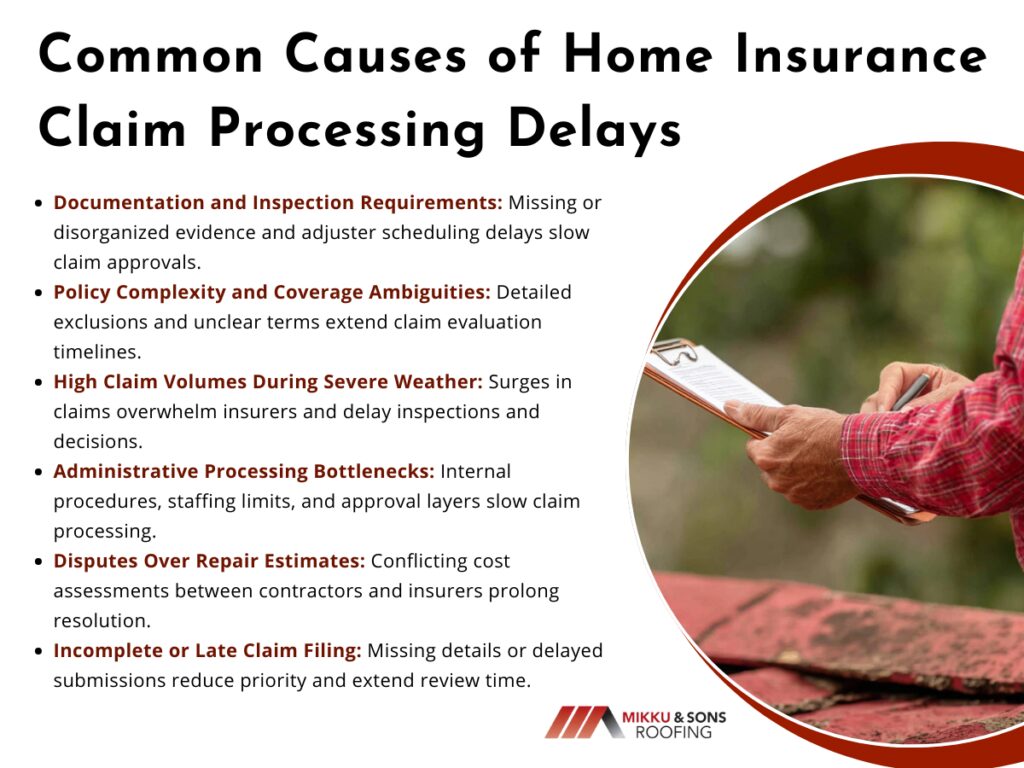
Insurance delays often frustrate homeowners during roof emergencies and prolong exposure to further damage. Delays may result from documentation gaps, complex policies, heavy claim volume, or administrative bottlenecks.
Awareness of these factors helps homeowners communicate effectively and accelerate approvals.
Insurers require comprehensive evidence to verify claims, which can extend approval timelines. Provide photos, repair estimates, and detailed descriptions of damage.
Adjusters often conduct in-person inspections to confirm structural integrity and assess risks. Scheduling depends on adjuster availability, property location, and workload, causing delays that last several days.
Organized, complete documentation prevents repeated requests and accelerates claim processing. Clear records improve communication between homeowners, contractors, and insurance adjusters.
Insurance policies contain detailed provisions, exclusions, and limitations that require careful review. Adjusters evaluate whether damages meet coverage terms, often extending approval timelines.
Disputes frequently arise over roof age, hail, wind, or prior maintenance requirements. Early clarification of these terms reduces misunderstandings and prevents unnecessary claim delays.
Review policies in advance and confirm coverage with the insurer to ensure the limits and exclusions that align expectations with actual benefits.
Severe weather events increase claims and overwhelm adjuster availability. Delays occur when multiple inspections and approvals are required simultaneously.
Communication gaps arise if insurers cannot promptly contact homeowners. Regular follow-up ensures claims remain active and reduces risk of lost updates.
Proactive homeowners prepare by documenting damage quickly and using licensed contractors. Early action mitigates delays and protects property from further deterioration.
Internal insurer procedures, staff shortages, and approval hierarchies often slow claims. Multiple departments may need to verify coverage, review estimates, or approve payments.
These procedural delays can take days or weeks, especially during peak seasons. Homeowners may experience confusion or repeated requests for the same information.
Maintaining clear, concise records and following submission instructions reduces administrative lag. Homeowners who anticipate these steps can avoid frustration and streamline approvals.
Conflicting repair estimates between contractors and insurers often delay claims. Adjusters may question materials, labor costs, or required repairs before approving coverage.
Homeowners frequently encounter back-and-forth discussions when contractors and insurers disagree. These disputes prolong timelines and leave homes vulnerable to ongoing damage.
Using licensed contractors who provide detailed, professional estimates can reduce conflicts. Documentation of damage and cost transparency accelerates approval and avoids unnecessary delays.
Claims submitted with missing information or delayed notices often face prolonged review. Insurers may return incomplete applications for clarification, further delaying repairs.
Late reporting can also influence claim priority, particularly during peak disaster seasons. Insurers may focus on early or urgent filings, leaving late submissions lower in queue.
Homeowners should file claims immediately after damage occurs and include complete documentation. Prompt, accurate filing ensures faster attention and minimizes risks of secondary damage.
Homeowners can take proactive steps to reduce insurance delays and accelerate roof emergency repairs. Organized preparation, timely communication, and professional support create smoother claim experiences.
These strategies ensure safety, protect property, and minimize the financial impact of prolonged waiting periods. Clear, structured action improves coordination between insurers, contractors, and homeowners.
Insurance adjusters approve claims faster when all supporting documents accompany the initial submission. Photos, videos, contractor estimates, and written damage descriptions provide clear evidence.
Include interior and exterior images, roof measurements, and previous repair records. Annotating photographs with dates and context strengthens the submission.
Licensed contractors provide detailed, professional estimates that insurers accept readily. Their expertise ensures repair scopes, material specifications, and cost breakdowns meet policy requirements.
Contractors may communicate directly with insurance adjusters to clarify repair plans. This direct liaison streamlines approvals and prevents disputes over coverage.
Working with contractors experienced in insurance claims benefits homeowners. Their reports reduce questions, accelerate inspections, and minimize approval bottlenecks.
Frequent updates with your insurer ensure claims remain active and visible. Track emails, phone calls, and online portal updates to avoid overlooked steps.
Documenting each interaction creates a paper trail in case of disputes. This record helps prove timely responses and cooperation with the insurer.
Regular communication prevents unnecessary pauses and ensures claims progress steadily. It also reduces homeowner stress during roof emergencies.
Taking immediate steps to protect the home demonstrates diligence to insurers. Temporary fixes reduce further damage while waiting for approval.
Common measures include placing tarps over exposed areas, securing loose shingles, and moving valuables from risk zones. Homeowners must avoid repairs that compromise safety or cause additional damage.
Temporary protective actions may include:
These measures preserve property value, improve safety, and support faster inspections. Insurers often view proactive homeowners as responsible, which can influence approval speed.
Replacing a roof after an insurance claim does not automatically increase premiums. Insurers consider the home’s age, claim history, and local risk factors before adjusting rates.
Proactive communication with your provider about repairs and coverage ensures transparency. Maintaining documentation of completed work and quality materials can demonstrate reduced risk, potentially preventing future rate increases.
Choosing a new roof that meets code requirements and reduces hazards may also improve insurance eligibility. These measures help homeowners protect their investment while stabilizing premiums over time.
Roof flashing might look like a thin strip of metal tucked between shingles and walls, but it is one of the most important barriers protecting your home from water damage. When roof flashing is installed incorrectly, it fails to guide rainwater away from joints and seams, allowing leaks to develop in hidden spots. Over time, these leaks can rot wood, weaken ceilings, and invite mold into the attic. In short, poor flashing installation often leads to expensive and preventable repairs.
What happens when roof flashing is installed incorrectly? This blog explains what roof flashing does, the most common installation mistakes, how to recognize early warning signs, and what steps you can take to repair or prevent roof flashing issues before they spiral into major structural problems.
Roof flashing is a thin, waterproof barrier usually made of metal such as aluminum, galvanized steel, or copper. Its job is simple but vital to direct water away from joints and intersections where the roof meets other structures. These include chimneys, skylights, vents, dormers, roof valleys, and the point where the roof connects to a wall.
Without flashing, rainwater would easily seep through small openings, damaging roofing materials and the layers beneath. Flashing works as a channel, redirecting water to the gutters or roof edge, protecting vulnerable seams from moisture.
Properly installed flashing is one of the strongest defenses against leaks and interior water damage. It bridges gaps that shingles or tiles alone cannot seal, especially where materials overlap or change direction. Even the highest-quality roof can fail if the flashing is poorly installed or maintained.
Flashing types vary depending on placement. Step flashing, for example, is used along sidewalls and layered between shingles to prevent water from sliding under. Counter flashing is installed over step flashing to lock out water around chimneys or masonry walls. Valley flashing protects roof valleys where water runoff is heaviest. Understanding each type helps you spot where problems are most likely to occur.
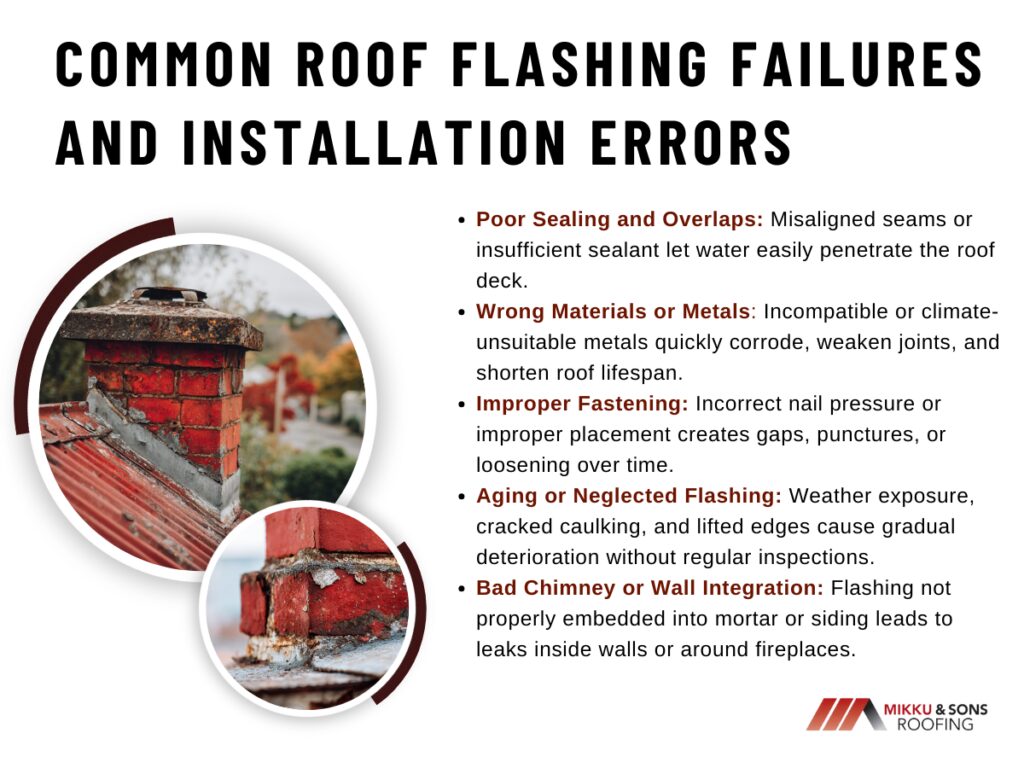
Improper flashing installation can occur for several reasons, from cutting corners during construction to using the wrong materials for the climate. Once moisture finds a weak point, it rarely stays contained. Below are the most frequent causes of roof flashing issues and why they matter.
Flashing pieces must overlap correctly and be sealed with compatible materials to create a watertight barrier. If seams are misaligned or not sealed properly, water can sneak behind the flashing and soak the roof deck. This often happens when installers use too little sealant or apply it to dirty or wet surfaces.
Not all flashing materials perform equally in every environment. Using thin aluminum in coastal regions, for example, can lead to premature corrosion from salt exposure. Mixing metals like copper and steel can also cause galvanic corrosion, weakening joints and creating pinholes where leaks form.
Using the wrong flashing material can reduce your roof’s lifespan by years and void manufacturer warranties. Always match materials to your local climate and roofing type.
Nails driven too tightly or too loosely can warp the metal, creating gaps for water to slip through. Overdriven nails may puncture the flashing, while underdriven ones loosen over time with expansion and contraction. Skilled roofers use specific fasteners and secure them at proper intervals to ensure a tight, flexible seal.
Even well-installed flashing wears out eventually. Sun exposure, temperature swings, and oxidation cause metal to expand, contract, and weaken. Caulking around chimneys and vents can crack or dry out, and flashing edges may lift during strong winds. Regular roof inspections help catch these signs before they cause major damage.
When flashing is poorly embedded into brick mortar or not tucked under siding, it allows rainwater to seep into the walls. Many homeowners notice leaks near the fireplace or along interior walls and assume the roof is to blame, when in fact the problem lies in flashing that wasn’t integrated correctly.
Roof flashing problems often start small but can quickly escalate. Since flashing is hidden beneath layers of roofing, leaks may go unnoticed until they cause visible interior damage. Knowing what to look for can save thousands in repairs.
Brown or yellow stains on ceilings near chimneys, skylights, or walls are common indicators of flashing leaks. Even minor discoloration suggests moisture infiltration that needs immediate attention.
Inspect your attic after heavy rain. Damp rafters, wet insulation, or mold growth near roof joints often point to compromised flashing rather than damaged shingles.
Sealant around roof penetrations can dry out over time. Once cracks appear, water seeps beneath the flashing and spreads across the underlayment.
Wind or temperature shifts can loosen flashing edges. Rust or corrosion indicates long-term exposure to moisture and metal fatigue.
Early detection of roof flashing issues prevents costly structural repairs and protects your home’s interior from further damage. A quick inspection after each season, especially after storms, can reveal these problems before they worsen.
Poor flashing installation can affect more than just your roof. Once water finds a way in, it travels along beams, insulation, and drywall. The longer it’s left unaddressed, the more severe the consequences become.
Below is a quick comparison of what happens when flashing is installed correctly versus incorrectly.
| Installation Quality | Resulting Condition | Typical Outcome |
| Properly installed flashing | Water directed safely to gutters | Dry roof deck, no leaks |
| Incorrectly installed flashing | Water seeps behind joints | Ceiling stains, structural damage |
| Regular maintenance and inspection | Early detection of wear | Low repair costs |
| No maintenance or inspection | Corrosion and separation | Costly roof replacement |
Ignoring flashing defects turns a minor maintenance issue into a full-scale roofing emergency. Regular inspection and timely repairs keep small problems from escalating into widespread damage.
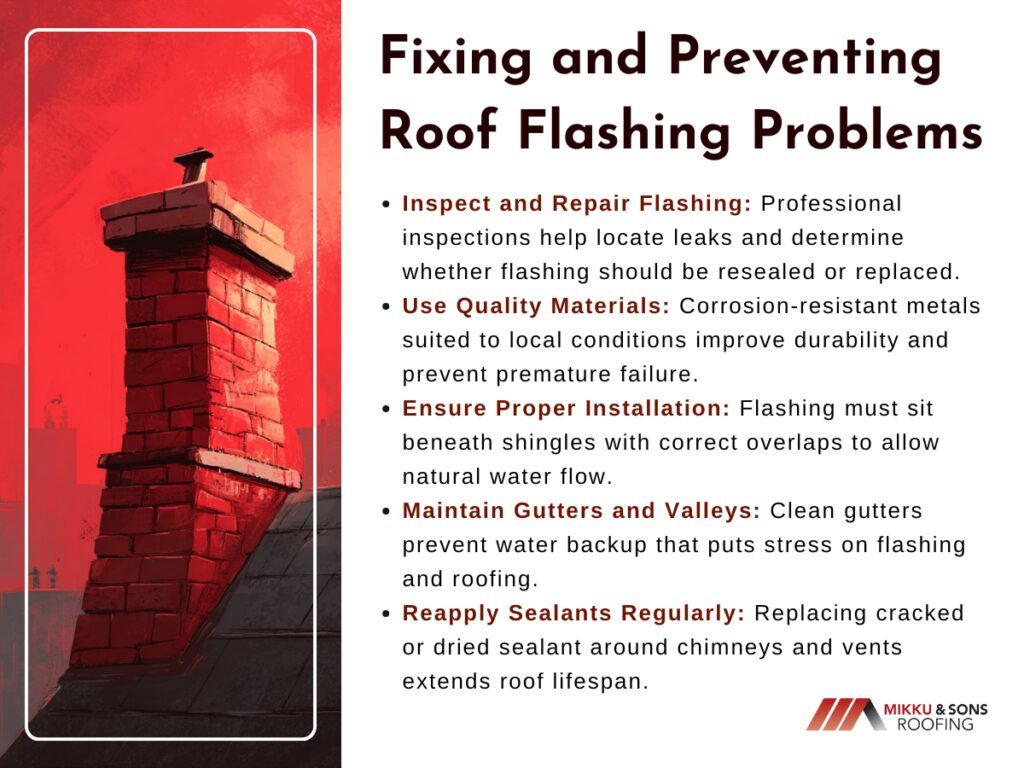
Correcting roof flashing issues starts with identifying the source of the leak. Because water follows complex paths, what looks like a ceiling stain near a chimney may originate several feet away. For this reason, professional roof inspection is often the safest route. Still, homeowners can take a few important steps to minimize risk and ensure long-term protection.
A licensed roofing contractor can pinpoint the exact source of flashing leaks using moisture meters and visual inspection. They will assess whether the flashing can be resealed or if sections need replacement.
Repair methods vary depending on the material. Steel flashing may require patching with compatible metal, while corroded sections often need full replacement. The roofer will reseal seams with roofing cement or specialized sealants and ensure overlaps follow correct direction and slope.
Hiring a professional ensures the flashing is not only repaired but also properly integrated with surrounding shingles, siding, or chimney mortar. This creates a lasting, watertight seal that holds up against seasonal changes.
Choose corrosion-resistant metals such as copper or galvanized steel for longevity. In areas with high humidity or salt exposure, stainless steel or coated aluminum provides extra durability. Avoid thin or mismatched metals that can corrode when exposed to each other.
Flashing must always be installed beneath or between shingles, not on top. Overlapping layers allow water to flow downward naturally. Each piece should overlap the next by at least two inches to ensure water cannot back up underneath.
Clogged gutters cause water to back up and overflow onto flashing areas, increasing the risk of leaks. Cleaning gutters at least twice a year allows rainwater to flow freely, reducing stress on the flashing and shingles.
Sealant and caulk around vents or chimneys dry out with sun exposure. Inspect these areas annually and replace deteriorated caulking before cracks widen. This simple task can add years to your roof’s life.
While small patch repairs may seem manageable, most flashing issues are best left to certified roofers. Working on a roof is physically demanding and risky, especially when steep slopes or fragile materials are involved.
Call a professional roofer if you notice any of the following:
Professional assessment ensures that repairs address the real problem rather than surface symptoms. Roofers can also check other weak points like skylight flashing, vent boots, and valleys to ensure your entire roofing system remains watertight.
Even high-quality flashing needs attention to stay effective. Integrate these habits into your seasonal maintenance routine:
Routine maintenance extends the life of both flashing and roofing materials. If your roof is over 15 years old, ask your roofer to inspect flashing during any scheduled maintenance or gutter cleaning.
Flashing is often the first component to fail when a roof begins to age, yet it is also one of the easiest to maintain. By keeping your flashing in good condition, you safeguard your entire roof system.
Roof flashing issues are a sign that water management on your roof is compromised. Addressing them early can prevent damage to shingles, underlayment, and even your home’s structure.
Healthy flashing equals a healthy roof. Each piece plays a small part in protecting your home from wind-driven rain, snow, and ice. Combined with proper ventilation, insulation, and gutter care, well-maintained flashing ensures that water flows where it should safely off your roof.
For older homes, consider scheduling a full roof inspection every two to three years. This allows contractors to reseal or replace worn flashing before problems develop.
Roof flashing may seem like a small detail, but it plays one of the biggest roles in keeping your home watertight. When installed correctly, it directs rainwater away from vulnerable joints around chimneys, vents, and valleys, protecting your roof’s structure and interior.
Most roof flashing issues start with poor workmanship or neglected maintenance, leading to leaks that spread silently over time. Regular inspections, prompt repairs, and choosing the right materials are your best defenses against moisture intrusion. Investing in proper flashing isn’t just maintenance, it's long-term protection for your roof, walls, and insulation. Next, explore how different roof flashing materials compare in durability and performance for lasting leak prevention.
A roof is one of the most critical structural elements in a rental property, serving as the first line of defense against weather, pests, and structural deterioration. Its condition directly impacts tenant safety, property value, and compliance with housing regulations.
Landlords bear a legal and ethical duty to maintain the roof in good working order throughout a tenancy. This responsibility ensures that the property remains habitable, energy-efficient, and free from water intrusion or structural hazards.
What You Need to Know about landlord roof responsibilities? Understanding the extent of roof maintenance obligations helps landlords avoid costly disputes, protect long-term investments, and maintain positive relationships with tenants. A proactive maintenance strategy also prevents minor issues from developing into major financial liabilities.
Landlords are legally required to provide and maintain a habitable property that meets local and state housing codes. The roof, as a structural and protective barrier, plays a vital role in ensuring that standard of habitability is met at all times.
When a roof becomes damaged or fails to perform its function, landlords may face fines, repair orders, or legal action from tenants and housing authorities. Regular maintenance and clear documentation protect landlords from liability while preserving property integrity.
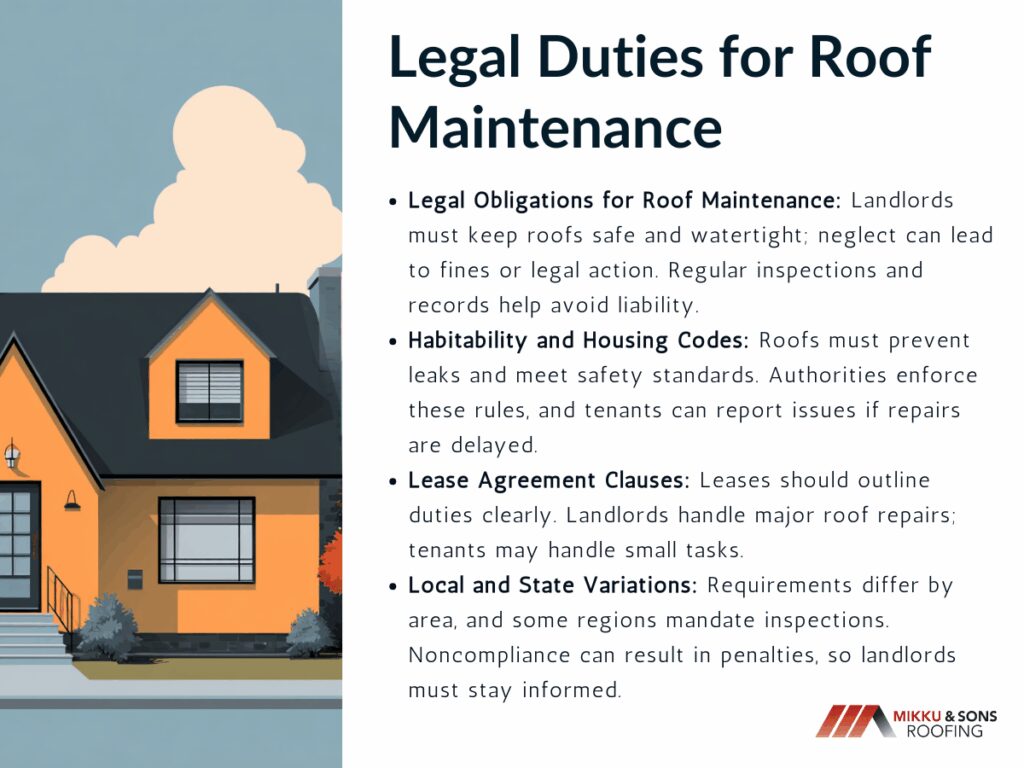
Most jurisdictions require that rental properties be structurally sound, watertight, and resistant to environmental hazards. A damaged or leaking roof can quickly compromise habitability by allowing moisture, mold, and temperature fluctuations inside the home.
| Requirement | Purpose | Typical Enforcement |
| Weatherproof structure | Prevents leaks and drafts | Local housing authority |
| Mold and moisture control | Maintains air quality | Health department |
| Structural integrity | Ensures roof stability | Building inspector |
| Safe materials | Avoids hazardous roofing | State housing standards |
Tenants who experience roof-related issues may be entitled to report violations, withhold rent, or terminate leases if repairs are ignored. Maintaining compliance through periodic inspections and timely repairs prevents such conflicts and legal complications.
Landlords should familiarize themselves with regional habitability laws and building codes, as these regulations outline acceptable roof conditions and repair timelines. Staying informed ensures that maintenance efforts align with local standards and inspection requirements.
The lease agreement serves as the primary document defining maintenance duties for both parties. It should specify the landlord’s responsibility for structural repairs, including roof replacement, while clarifying tenant duties such as routine cleaning of gutters or debris removal.
Although leases may attempt to assign certain responsibilities to tenants, structural integrity and major repairs typically remain the landlord’s legal obligation. Attempting to bypass this requirement can result in invalid lease terms or disputes during tenancy.
Landlords are encouraged to review and update lease agreements regularly to reflect changes in property condition and legal standards. This ensures mutual understanding, reduces ambiguity, and supports a fair balance of responsibilities.
Roof maintenance requirements can differ significantly from one jurisdiction to another. Some states enforce detailed housing standards, while others grant municipalities authority to determine inspection intervals and repair mandates.
Local ordinances may require landlords to submit proof of inspection or address violations within a specific timeframe. Ignoring these requirements can lead to escalating penalties or rental license suspension.
Landlords operating in multiple regions should research each location’s specific rules before leasing properties. Consulting a real estate attorney or property management expert ensures compliance across different regulatory environments.
Preventive maintenance is essential for extending roof lifespan and avoiding sudden, costly repairs. Landlords should establish a consistent inspection schedule that identifies damage before it affects tenants or causes interior deterioration.
Routine upkeep not only preserves property value but also demonstrates a landlord’s commitment to providing a safe and well-maintained living environment. Documenting maintenance efforts supports transparency and legal protection in the event of tenant disputes.
Roof inspections should occur at least twice a year, ideally in the spring and fall. These periods allow landlords to assess damage caused by seasonal weather changes and address small issues before they escalate.
Professional inspections are particularly important after severe weather events such as storms, heavy rainfall, or strong winds. Early detection of missing shingles, water intrusion, or flashing damage prevents larger structural repairs.
Landlords should also perform visual checks between professional visits to monitor signs of aging or wear. Keeping a record of inspection dates and findings helps demonstrate compliance with maintenance obligations.
Routine maintenance includes clearing gutters, removing debris, and ensuring roof vents are unobstructed. These simple tasks prevent water pooling, structural stress, and pest infestations that can weaken roofing materials over time.
| Inspection Type | Timing | Purpose |
| Professional inspection | Twice yearly | Identify structural issues |
| Post-storm check | After major weather | Detect storm-related damage |
| Tenant visual report | Ongoing | Early issue reporting |
| Drone or visual scan | As needed | Large property assessment |
Addressing minor repairs such as sealing cracks or replacing damaged tiles immediately extends the lifespan of the entire roof. Delayed maintenance often results in widespread leaks that affect ceilings, insulation, and walls.
Hiring licensed roofing contractors for periodic evaluations ensures repairs meet building codes and warranty conditions. Proper documentation of professional work protects landlords from potential disputes or liability claims.
Gutters and downspouts are crucial in directing rainwater away from the structure. When clogged or damaged, they can cause roof edge deterioration, water intrusion, and foundation erosion.
| Component | Purpose | Common Issue | Preventive Action |
| Gutter | Directs water flow | Clogging from leaves | Clean regularly |
| Downspout | Moves water away from base | Blockage or detachment | Inspect after rain |
| Gutter guard | Reduces debris | Rusting or bending | Replace as needed |
| Splash block | Protects foundation | Misalignment | Reposition periodically |
Landlords should ensure gutters are cleaned at least twice annually and inspected for proper slope and attachment. Neglecting this system can lead to costly roof and structural repairs, especially during heavy rain seasons.
Installing gutter guards and downspout extensions minimizes debris buildup and improves drainage efficiency. Maintaining these components reinforces the overall durability of the roof system.
Clear communication between landlords and tenants is essential when roof problems occur. Prompt attention to repair requests not only prevents property damage but also builds tenant trust and satisfaction.
A well-organized repair process helps landlords manage costs, coordinate contractors efficiently, and maintain compliance with habitability standards. Documenting all communications and actions ensures accountability.
Tenants should have an easy and reliable way to report roof issues such as leaks, water stains, or unusual noises. Prompt acknowledgment and investigation of these concerns demonstrate professionalism and responsibility.
Landlords must respond quickly, especially if the damage threatens tenant safety or property integrity. Delayed action can result in additional repairs, legal complaints, or withheld rent.
Establishing a written policy for reporting maintenance issues ensures consistency across properties. It also provides a clear record of each repair request and its resolution timeline.
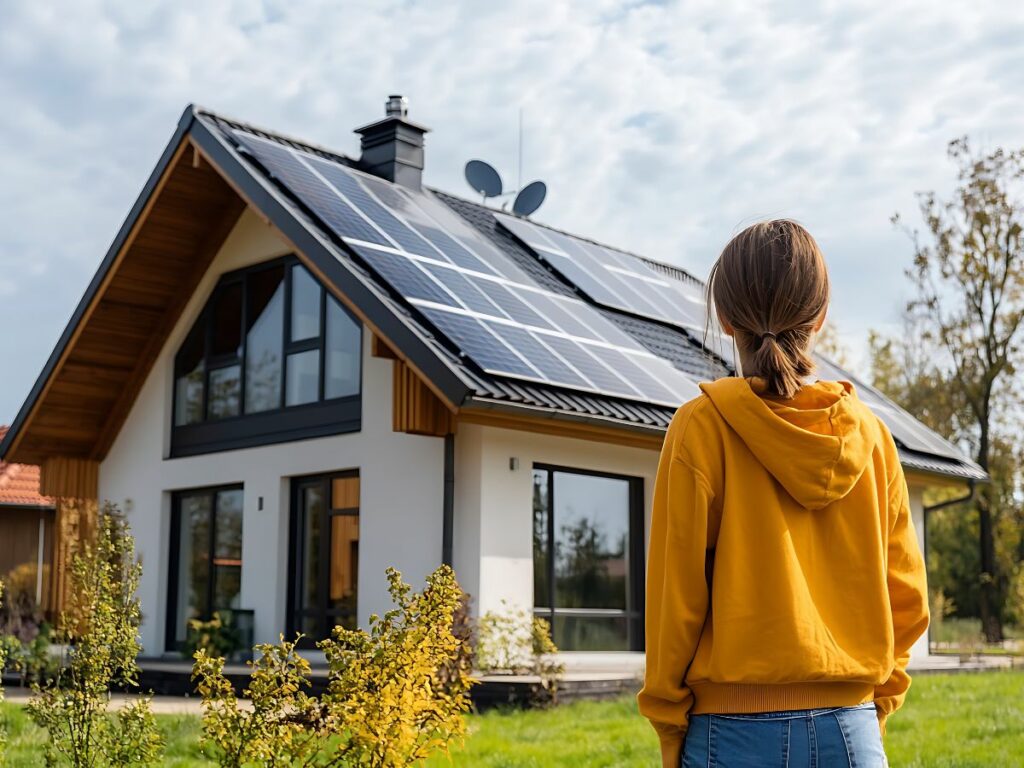
Hiring experienced, licensed, and insured roofing professionals guarantees compliance with building codes and quality workmanship. Contractors should provide detailed estimates and warranties for both materials and labor.
Obtaining multiple bids helps landlords balance cost and quality before approving repairs. Cheaper options may lead to substandard work, which can increase expenses in the long term.
Maintaining relationships with reliable contractors ensures quicker response times during emergencies. Consistent vendor partnerships also streamline administrative tasks like invoicing and warranty management.
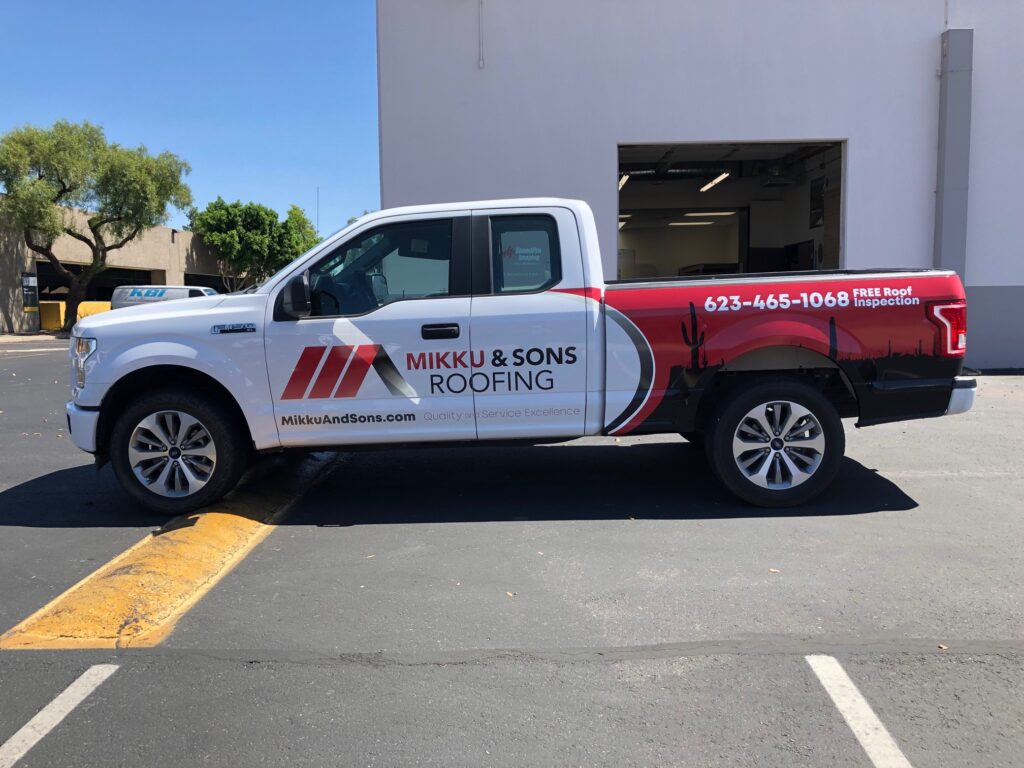
Detailed documentation of inspections, repairs, and invoices protects landlords against potential disputes. It provides verifiable proof that maintenance responsibilities were fulfilled according to legal and contractual obligations.
Maintaining organized records supports insurance claims and property value assessments. In case of litigation, this documentation can demonstrate compliance and proactive management.
Digital maintenance logs or property management software simplify recordkeeping. They ensure accessibility of maintenance data across different rental units and property portfolios.

Every roof has a finite lifespan, depending on material type, installation quality, and local climate. Planning for eventual replacement ensures financial preparedness and uninterrupted tenant safety.
Landlords who adopt a long-term maintenance strategy can schedule replacements efficiently and budget responsibly. Regular evaluations help determine the right time for upgrades without disrupting occupancy.
Visible deterioration such as curling shingles, sagging areas, or chronic leaks signals the need for full replacement. Ignoring these signs risks extensive interior damage and insurance complications.
Professional assessments help landlords compare repair costs with replacement benefits. When repair expenses approach half the cost of a new roof, replacement is often the more practical solution.
Modern roofing materials offer improved durability, energy efficiency, and warranty coverage. Upgrading to these materials enhances both property appeal and long-term value.

Roof replacement is a significant expense that requires careful financial planning. Setting aside annual reserves based on roof age and size ensures funds are available when needed.
Obtaining quotes from multiple contractors helps refine cost expectations and identify realistic timelines. Transparent budgeting avoids financial strain and allows for timely project completion.
Including roof replacement costs in annual maintenance budgets promotes proactive asset management. This approach aligns with long-term investment goals and reduces emergency spending.

Roof replacements can temporarily disrupt normal living conditions. Landlords should communicate scheduling details, expected noise levels, and safety precautions in advance.
Providing tenants with updates and estimated completion dates fosters cooperation during the project. Offering temporary accommodations or rent adjustments may be necessary for extensive work.
Maintaining open communication throughout the process demonstrates professionalism and reduces complaints. Clear coordination ensures the replacement is completed safely and efficiently.

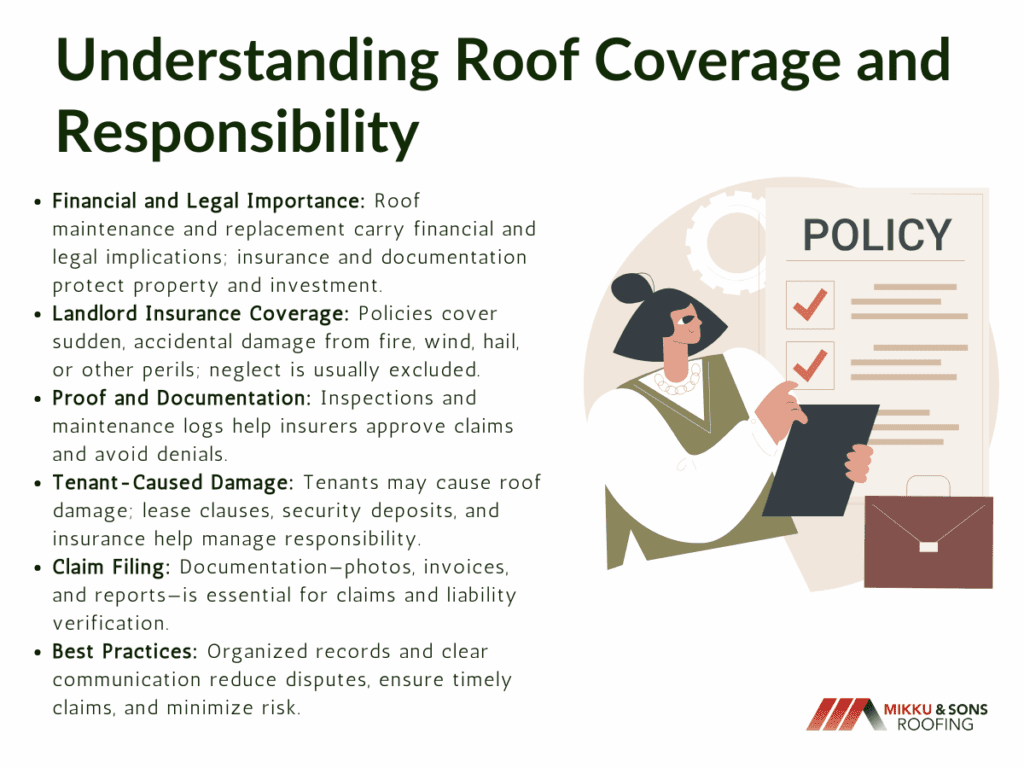
Roof maintenance and replacement carry financial and legal implications that extend beyond routine repairs. Landlords must understand how insurance coverage, liability, and proper documentation protect both property and investment.
Proper insurance safeguards landlords from unexpected expenses caused by storm damage, accidents, or structural failure. Ignoring these considerations may result in denied claims, legal disputes, and substantial out-of-pocket costs.
Landlord insurance policies generally cover property damage caused by fire, wind, hail, or other covered perils. Roof repairs and replacements may be included if the damage is sudden and accidental rather than due to neglect or poor maintenance.
Insurance companies often require proof of regular inspections and maintenance records to approve claims. Without proper documentation, insurers may deny coverage for issues related to wear and tear or deferred maintenance.
Maintaining a detailed log of roof inspections, repairs, and upgrades demonstrates diligence and ensures claims are processed efficiently. This approach protects landlords from unforeseen financial liabilities while keeping the property in compliance with insurance requirements.

Tenants can occasionally cause roof damage through negligent actions, such as improperly installing equipment, leaving debris, or climbing on the roof. These incidents may not be covered under standard insurance policies unless specifically addressed.
Landlords should clarify lease clauses regarding prohibited roof access and tenant responsibilities. Security deposits can sometimes offset minor tenant-caused damages, but insurance coverage is preferred for major repairs.
Documentation is essential: photographs, repair invoices, and incident reports provide evidence in disputes or insurance claims. Clear communication about tenant responsibilities reduces the likelihood of damage and liability conflicts.
Filing an insurance claim for roof damage requires comprehensive records, including inspection reports, repair estimates, and photographic evidence of the issue. Insurance adjusters rely on these materials to verify the legitimacy and cause of the claim.
Landlords should maintain a consistent system for logging maintenance, repairs, and incidents. Organized documentation ensures timely claim processing and strengthens the landlord’s legal position if liability questions arise.
Regularly reviewing insurance policies ensures coverage is adequate for the property type, roof material, and local environmental risks. Updating policies after major repairs or replacements aligns coverage with current property value and reduces potential financial exposure.
Landlords hold a critical responsibility in ensuring the roof remains safe, functional, and compliant with housing standards. Regular inspections, preventive maintenance, and prompt repairs safeguard both property and tenant well-being.
As roofs age, their condition becomes an increasingly important factor in real estate valuation and buyer perception. This relationship underscores why homebuyers pay close attention to roof age when assessing potential properties.
A newer roof often signals proper maintenance and lower future repair costs, increasing property desirability. Understanding this connection helps landlords plan improvements strategically to maximize long-term investment value.
In most situations, installing a new roof won’t cause your insurance to increase, it's more likely to reduce your premium. Insurers view a new roof as a sign of lower risk since it provides stronger protection against leaks, weather damage, and other costly issues. Because your roof is one of the most critical components of your home’s structure, replacing an old or worn one can lead to meaningful savings on your homeowners insurance.
Will my insurance go up if I get a new roof? This article explores why your roof plays such a key role in insurance pricing and outlines when a roof replacement can lead to lower rates. It also covers the main factors that influence potential discounts, strategies to maximize your insurance savings, and typical savings homeowners can expect after investing in a new roof.
Your roof is a critical part of your home from an insurance perspective, serving as the first line of defense against weather, water damage, and structural issues. A well-maintained or new roof lowers the risk of costly claims from leaks, mold, or storm damage, making your home less risky to insure and often resulting in lower premiums.
In contrast, an aging or damaged roof increases the likelihood of claims, which can raise premiums or make coverage harder to obtain. Insurers carefully evaluate your roof’s age, material, and condition, and a strong, well-built roof signals better protection,benefiting both your home and your wallet.

Replacing your roof can do more than improve your home’s appearance, it can also lower your homeowners insurance premiums. Insurers view a new roof as a sign of reduced risk, which can translate into meaningful savings. Here’s a closer look at how a new roof can help reduce your insurance costs:
A new roof lowers the chance of leaks, water damage, and storm-related problems. With fewer risks, insurers often reduce your premium, and it also protects ceilings, walls, and electrical systems from damage.
Impact-resistant, fire-resistant, or energy-efficient roofing materials can earn extra discounts. Premium options like metal, slate, or Class 4 shingles last longer and require less maintenance, especially in extreme weather areas.
Roofs built to modern codes improve structural integrity and reduce the likelihood of storm damage. Meeting current standards may also lower liability and insurance risk during severe weather events.
A new roof needs less upkeep and has fewer hidden problems that could lead to claims. This lowers long-term liability, making your home safer and more attractive to insurers.
Some insurers offer extra savings for energy-efficient, reflective, or fire-resistant features. Combining multiple upgrades can maximize the total discount on your premium.
A new roof strengthens your home against wind, hail, and storms, reducing the likelihood of claims. It may also qualify you for additional storm or disaster-specific insurance incentives in high-risk areas.
A new roof does more than enhance your home’s appearance, it reduces risk, increases durability, and often results in lower homeowners insurance premiums. By choosing durable materials, ensuring professional installation, and meeting code requirements, you can maximize both your home’s protection and potential insurance savings over time.
While most homeowners see savings after installing a new roof, there are cases where your insurance premium might stay the same or even increase slightly. These situations usually involve changes in your home’s overall value, coverage limits, or external factors that affect insurance pricing. In some cases, homeowners also need to think about how filing a roof claim itself can affect future premiums, since claim history can play a role in how insurers evaluate risk.
If your new roof uses premium materials like slate or metal, it can raise your home’s replacement cost. Since insurance must cover the full cost of rebuilding, a higher property value can lead to a higher premium.
Failing to report your new roof to your insurance company can prevent you from receiving potential discounts. Worse, inaccurate information about your roof’s age or materials could affect your coverage later.
Sometimes, when you update your policy after a roof replacement, your insurer re-evaluates other risks such as inflation, regional weather trends, or local claim rates. These external factors might offset any savings from your new roof.
In summary, while a new roof usually lowers insurance costs, other factors like home value adjustments, communication with your insurer, and broader market changes can influence whether your premium goes up or down.
Several key factors influence how much of a discount you’ll receive on your homeowners insurance after installing a new roof. Insurers evaluate not just the fact that you replaced your roof, but also the materials used, your home’s location, and the overall risk profile of your property. Understanding these factors can help you make choices that maximize your savings.
Different roofing materials offer varying levels of durability, fire resistance, and impact protection. Insurers often provide bigger discounts for materials that last longer and better withstand extreme weather.
| Roofing Material | Average Lifespan | Potential Discount Range | Notes |
| Asphalt Shingles | 15–30 years | 5–10% | Standard option; discounts depend on quality |
| Metal Roof | 40–70 years | 10–20% | Fire-resistant and energy-efficient |
| Impact-Resistant Roof | 30–50 years | 15–35% | Ideal for hail or storm-prone areas |
| Tile or Slate | 50+ years | 5–15% | Long lifespan but higher replacement cost |
The newer your roof, the lower your risk of leaks or storm damage. Most insurers offer the best discounts for roofs less than five years old, with benefits decreasing as the roof ages.
Some roof designs, such as hip roofs, perform better in high winds than gable roofs, making them less susceptible to wind damage. Insurers may factor this into premium calculations, especially in hurricane-prone regions.
Your home’s location plays a major role in determining insurance discounts. Areas prone to hurricanes, hail, or wildfires may see larger incentives for weather-resistant roofs.
| Region | Primary Risk | Discount Focus |
| Coastal Areas | Hurricanes & Wind | Wind-resistant materials |
| Midwest | Hailstorms | Impact-resistant shingles |
| West | Wildfires | Fire-resistant materials |
| South & Southwest | Heat & UV Damage | Reflective or cool roofs |
Insurers are more likely to offer discounts if your roof is installed by a licensed, certified contractor and meets local building codes. Proper installation ensures durability and reduces future claim risks.
In conclusion, the size of your insurance discount depends on a mix of factors from the type and age of your roof to your location and installation quality. To maximize savings, choose materials suited to your region’s climate, hire qualified professionals, and keep your insurer informed about your upgrade. A little planning can translate into long-term protection and lower insurance costs.
Maximizing your insurance savings after installing a new roof involves careful planning, proper installation, and proactive communication with your insurer. By taking the right steps, you can ensure you qualify for all available discounts and get the most value from your investment.

Keep detailed records, including receipts, warranties, and material specifications. Providing proof of your roof replacement helps your insurer verify the upgrade and apply any eligible discounts.
Always use licensed, certified professionals for installation. Insurers often require professional installation to qualify for discounts and to ensure the roof meets building codes.
Contact your insurance company to inquire about “new roof” or material-specific discounts. Being proactive ensures you don’t miss out on potential savings.
If your current insurer offers limited savings, get quotes from other providers. Comparing rates can help you find the best deal for your upgraded home.
Some insurers may require a quick inspection of the new roof before applying discounts. This ensures eligibility and can speed up the approval process.
In conclusion, keeping thorough records, using certified contractors, and actively communicating with your insurer are key to maximizing savings. These steps not only help lower your premiums but also protect your home more effectively.
The amount you can save on homeowners insurance after installing a new roof varies depending on factors such as materials, roof age, location, and insurer policies. While savings differ from home to home, understanding typical ranges can help you set realistic expectations.
| Roof Type | Typical Discount Range | Notes |
| Asphalt Shingles | 5–10% | Standard option; discounts depend on quality and age |
| Metal Roof | 10–20% | Durable, fire- and wind-resistant |
| Impact-Resistant Roof | 15–35% | Ideal for hail- or storm-prone areas |
| Tile or Slate | 5–15% | Long lifespan, but higher replacement cost |
On average, most homeowners can expect to save 5–20% on their premiums after installing a new roof, with greater savings possible for impact-resistant or high-end materials. While the exact discount depends on your roof and location, investing in a quality replacement not only protects your home but can also lead to meaningful long-term insurance savings.
Installing a new roof is a smart way to protect your home and often lower your homeowners insurance premiums. It reduces the risk of leaks, storm damage, and other costly issues, with insurers typically offering discounts for these improvements. Factors like materials, roof age, design, location, and professional installation all affect potential savings.
By documenting the work, hiring certified contractors, and taking advantage of available discounts, you can maximize the financial benefits. A new roof not only enhances your home’s protection and appearance but can also provide long-term insurance savings, making it a worthwhile investment.
Metal roofing has evolved from a purely functional solution into a durable, efficient, and aesthetically refined option for modern homes. Among the choices homeowners face, the decision between textured and smooth metal surfaces influences both performance and appearance.
Each surface type offers unique benefits depending on climate, architectural design, and maintenance expectations. Selecting the right finish affects not only durability but also comfort, noise control, and long-term satisfaction.
Metal roof texture impacts reflectivity, traction, and resistance to wear. Which Is Better for Your Home?Textured Metal Roof vs Smooth. Both styles can perform exceptionally when properly installed and maintained, but their differences matter in everyday use.
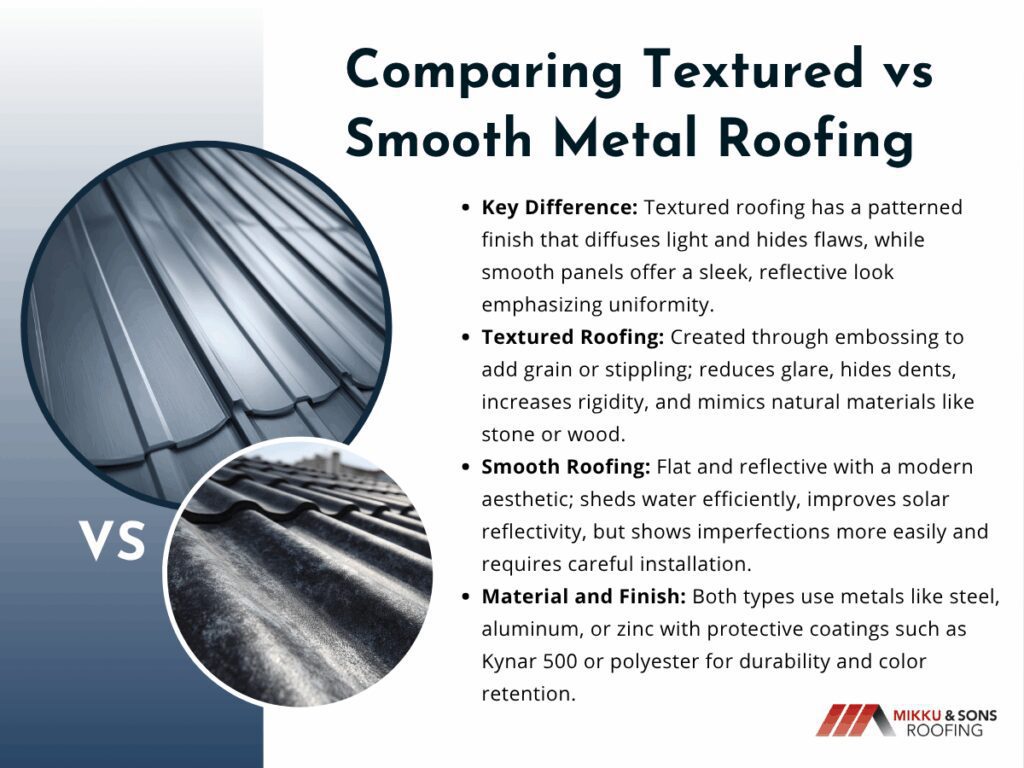
The distinction between textured and smooth metal roofing lies primarily in surface finish and tactile quality. Texture introduces a subtle pattern or grain that alters how light and water interact with the metal.
Smooth panels, in contrast, present a clean and polished look that emphasizes uniformity. These visual and structural variations directly influence performance under real-world conditions.
Textured roofing panels undergo an embossing process that presses small patterns or grains into the surface. This creates a tactile finish that diffuses light and conceals minor imperfections.
The texture can vary from fine matte stippling to deeper patterns resembling stone or wood grain. These surfaces reduce glare and help hide scratches, dents, or oil canning common on large panels.
Embossed panels also slightly increase rigidity without adding weight. The subtle structural variation improves panel strength and resistance to bending under stress.
Smooth panels feature a flat, reflective surface with uniform color and minimal variation. This style offers a contemporary appearance suited to modern and minimalist architecture.
The smooth finish allows water and debris to shed efficiently, reducing buildup in valleys or seams. It also enhances solar reflectivity, helping control heat absorption in warm climates.
Because the surface lacks patterning, imperfections are more visible, especially in large unbroken panels. Proper installation is essential to prevent oil canning and maintain visual consistency.
Both textured and smooth roofing can be manufactured from steel, aluminum, or zinc. Coatings such as Kynar 500 or polyester paint systems add corrosion resistance and color stability.
Textured coatings often include matte or low-gloss finishes to enhance subtlety, while smooth options emphasize reflectivity and precision. The right combination depends on architectural goals and climate conditions.
These differences influence not just appearance but also the tactile and thermal behavior of the roof over time. Each finish interacts differently with sunlight, precipitation, and airborne debris.
The performance of textured versus smooth metal roofing depends on environmental exposure and material thickness. Texture provides slight structural reinforcement, whereas smooth panels rely more on gauge and fastening precision.
Durability outcomes are shaped by how each surface manages impact, expansion, and weathering. Both can last over 40 years with proper installation and coating maintenance.
Textured roofing better conceals small dents or surface blemishes. The pattern diffuses light, minimizing visibility of imperfections that might otherwise stand out on smooth panels.
This quality makes textured options ideal for areas exposed to hail, falling branches, or foot traffic during maintenance. Smooth finishes, while equally strong, reveal damage more readily.
For homeowners prioritizing long-term aesthetics, embossed finishes help preserve visual appeal despite wear. The difference becomes most noticeable after several seasons of exposure.
All metal roofs expand and contract with temperature changes. Textured panels, with their micro-patterned surfaces, absorb stress more evenly across the sheet.
This helps reduce the likelihood of warping or oil canning in wide panels. Smooth metal expands in a more uniform but visually noticeable pattern, especially under direct sunlight.
Proper fastening systems and spacing accommodate these shifts in both surface types. Professional installation ensures stability and prevents premature wear.
Both textured and smooth roofing systems excel at shedding rain and snow due to their nonporous coatings. However, texture can slightly slow water flow, reducing splatter near edges and downspouts.
Smooth surfaces may dry faster but can reveal streaking or dirt accumulation over time. Textured coatings hide residue more effectively, maintaining a cleaner appearance between washes.
With proper coatings and maintenance schedules, both finishes resist rust and UV degradation for decades. The difference lies primarily in visual aging rather than structural integrity.
Beyond performance, the choice between textured and smooth metal roofing often comes down to style. Each finish interacts differently with architecture, light, and color.
Texture creates depth and shadow that soften the roof’s appearance, while smooth panels highlight geometry and precision. Both can elevate curb appeal when matched thoughtfully with exterior elements.
Textured metal roofs complement traditional, rustic, or transitional home designs. Their subdued surface reduces glare and adds warmth to exteriors with natural materials like stone or wood.
Smooth finishes pair well with contemporary and modern structures. Their reflective surfaces emphasize sharp lines and symmetry in minimalist architecture.
Homeowners often choose based on how the roof integrates with siding, trim, and landscaping. Visual balance enhances the overall harmony of design.
Smooth metal roofs typically produce higher solar reflectance, contributing to energy efficiency in sunny climates. Textured finishes, with their micro-diffused surfaces, slightly reduce glare and color intensity.
| Finish Type | Gloss Level | Solar Reflectance (SR) | Surface Temperature Reduction | Recommended Climate |
| Smooth Gloss | High | 0.65–0.75 | Up to 15°F cooler | Hot, sunny regions |
| Smooth Matte | Medium | 0.55–0.65 | Moderate | Temperate climates |
| Textured Matte | Low | 0.45–0.55 | Minimal | Cold or overcast areas |
| Textured Coated | Low to Medium | 0.50–0.60 | Slight | Mixed climate conditions |
This variation affects how colors appear under daylight and over time. Matte coatings on textured panels maintain consistent tone, while glossy smooth finishes shift subtly with changing light.
Choosing finish and color together ensures the desired visual effect endures for decades. A well-coordinated palette can enhance both resale value and environmental performance.
Surface maintenance varies between the two finishes. Smooth roofs require more frequent cleaning to remove debris and water marks that show on reflective surfaces.
Textured finishes mask dust, pollen, and minor scratches more effectively, requiring less frequent upkeep. However, heavy dirt buildup may accumulate in deeper grains if not rinsed occasionally.
Both benefit from annual inspections and gentle washing with mild detergent. Regular maintenance extends coating life and preserves appearance across all climates.
Installation complexity and cost depend on surface type, material thickness, and panel style. Textured panels generally cost slightly more due to additional embossing steps.
However, the difference is often offset by their enhanced resistance to visual imperfections and easier handling. Smooth panels, when installed flawlessly, deliver a high-end finish favored by architects.
Textured metal panels are less prone to visible oil canning during installation. The embossing naturally masks small irregularities in substrate or fastening alignment.
This tolerance makes them more forgiving for installers and reduces aesthetic risk. Smooth panels demand greater precision in fastening and substrate preparation.
Contractors often recommend textured finishes for large or uneven roof spans. Smooth options perform best on smaller, well-supported structures.
Embossed finishes add a minor premium to material cost, typically ranging from $0.25 to $0.50 more per square foot. The total expense varies with coating type and manufacturer.
| Material | Smooth Finish Cost (per sq. ft.) | Textured Finish Cost (per sq. ft.) | Estimated Installation Cost Range |
| Steel | $6.00 – $9.00 | $6.50 – $9.50 | $10.00 – $13.00 |
| Aluminum | $7.00 – $10.00 | $7.25 – $10.50 | $11.00 – $14.00 |
| Zinc | $12.00 – $15.00 | $12.50 – $15.50 | $16.00 – $20.00 |
| Copper | $14.00 – $20.00 | N/A (typically smooth only) | $18.00 – $25.00 |
Smooth finishes may require more labor time for precise alignment and seam control. Installation errors are more visible, leading to higher quality assurance costs.
Homeowners should consider both initial pricing and potential maintenance implications. Over the lifespan of the roof, the performance difference is often negligible compared to aesthetic preference.
Most manufacturers offer identical warranty terms for both textured and smooth panels. Lifespans typically range from 40 to 50 years, depending on metal type and coating.
Warranty protection focuses on coating integrity and color retention rather than surface style. This ensures equal performance when properly maintained.
Regular inspection and cleaning remain critical to preserving warranty validity. Both surfaces respond well to proactive care and professional maintenance schedules.
The decision between textured and smooth metal roofing often hinges on lifestyle and environmental factors. Homeowners should assess visual goals, maintenance tolerance, and local weather conditions.
Practical considerations such as noise, debris accumulation, and energy performance also influence satisfaction. A balanced evaluation leads to the most appropriate long-term investment.
In coastal or humid regions, both finishes require protective coatings to prevent corrosion. Textured surfaces can trap salt particles more easily if not rinsed regularly.
Smooth roofs perform slightly better in heavy rain regions due to faster runoff. In colder climates, both shed snow efficiently when installed with proper pitch.
Environmental conditions should guide coating selection and maintenance routines. This ensures longevity regardless of surface style.
Textured metal roofs slightly dampen rain and hail noise due to their micro-patterned surface. The embossing disrupts sound wave reflection, softening acoustic resonance.
Smooth panels, while not inherently noisy, may produce sharper sound during heavy rain or hail without proper insulation. Underlayment materials play a crucial role in both cases.
Acoustic insulation or foam backing beneath panels enhances comfort across all finishes. Homeowners sensitive to sound often find textured surfaces preferable.
Routine inspection and washing remain the foundation of metal roof upkeep. Textured surfaces require occasional rinsing to prevent dirt accumulation, while smooth roofs benefit from more frequent cleaning.
Sealant and fastener checks should occur annually for both types. Protective coatings extend lifespan and preserve color stability under UV exposure.
Developing a maintenance plan tailored to local weather ensures consistent appearance and performance. Professional cleaning every few years supports warranty compliance.
Both textured and smooth metal roofs offer strength, longevity, and refined aesthetics when properly installed. The choice depends on climate, design preference, and maintenance expectations rather than structural performance.
Texture adds subtle depth and resilience, while smooth panels highlight modern precision and reflectivity. Each serves homeowners seeking durable beauty with minimal compromise.One key consideration often linked to surface type is acoustic comfort during rainfall. Effective insulation, underlayment, and design solutions can dramatically improve this experience.
Roofing technology has evolved dramatically, offering homeowners materials engineered for durability, weather resistance, and long-term protection. Among these innovations, impact-rated asphalt shingles have become a key focus for those living in areas exposed to severe storms or hail.
The classification system, developed through Underwriters Laboratories (UL) impact testing, measures a shingle’s ability to withstand hail and debris without cracking. Class 3 and Class 4 shingles represent the highest levels of performance in this testing standard, setting them apart from traditional roofing options.
Investing in higher-rated shingles can influence not only roof lifespan but also insurance costs, energy efficiency, and resale value. For Arizona, Texas, and other hail-prone regions, knowing the difference between Class 3 vs Class 4 shingles helps homeowners make a cost-effective, long-term decision.
Impact ratings were designed to create a consistent way to measure roofing resilience against hail or falling debris. This system allows contractors and homeowners to evaluate materials based on proven physical testing rather than marketing claims.
Each shingle rating, Class 1 through Class 4, is determined by dropping steel balls of various sizes from specific heights to simulate hail damage. Class 3 and Class 4 represent the upper tiers of performance, providing measurable differences in impact resistance and long-term protection.
The UL 2218 impact resistance test is the industry standard used by manufacturers and insurance companies. A Class 3 shingle must resist damage from a 1 3⁄4-inch steel ball dropped from 17 feet, while a Class 4 shingle must remain intact after impact from a 2-inch steel ball at the same height.
Manufacturers submit products for testing to independent laboratories, ensuring that ratings remain consistent and reliable across brands. These tests measure not only surface damage but also whether cracks penetrate through to the shingle’s backing material.
A Class 4 result signifies the shingle sustained no visible cracks or material separation under maximum impact. This rating represents the highest certification available and indicates exceptional durability under severe weather conditions.
Impact resistance focuses on preventing punctures and cracks caused by falling debris, while wind resistance measures a roof’s ability to remain sealed under strong gusts. Although they are separate metrics, both play critical roles in total roof performance.
Class 3 and Class 4 shingles typically offer higher wind ratings because stronger materials are used in their construction. Many Class 4 shingles can resist winds exceeding 130 miles per hour, matching standards required for hurricane zones.
Understanding both metrics helps homeowners evaluate total roof protection, especially in regions with combined threats of wind and hail. Together, these ratings influence overall insurance coverage and potential premium discounts.
Severe weather can cause significant roof damage that leads to leaks, structural deterioration, and costly repairs. Higher impact ratings reduce the likelihood of such issues, offering both peace of mind and financial benefits.
In many cases, insurance providers offer reduced premiums for homes with Class 4 shingles due to their lower risk profile. Over time, these savings can offset part of the installation cost, making the upgrade financially advantageous.
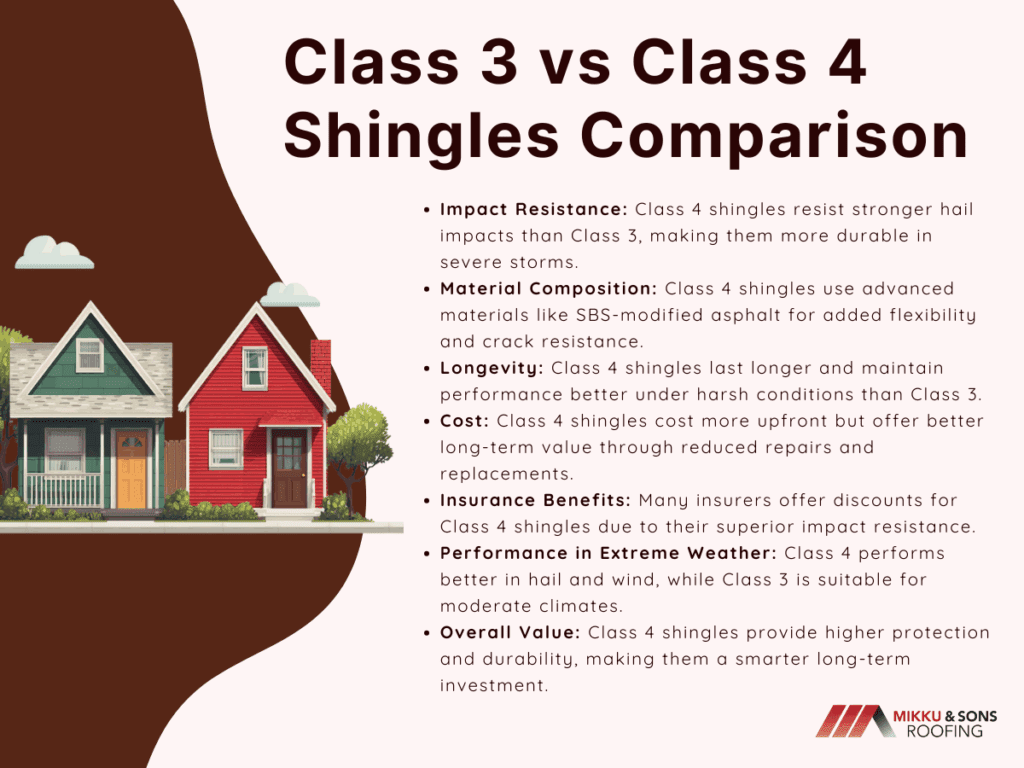
Homeowners who plan to stay in their property for several years typically see long-term returns in reduced maintenance and improved resale appeal. For regions frequently affected by hailstorms, Class 4 protection is often viewed as a necessary investment rather than a luxury.
Class 3 shingles are designed to balance durability and affordability, making them suitable for areas with occasional but not extreme weather events. Their reinforced design offers greater protection than standard shingles while keeping material costs reasonable.
Many homeowners select Class 3 shingles when they seek improved performance without the full investment of premium roofing materials. These shingles often serve as a transitional option between basic and high-end impact-rated roofs.
Class 3 shingles typically feature a fiberglass or asphalt base reinforced with polymer-modified asphalt. This composition allows the material to flex slightly under impact, reducing the chance of surface cracking.
Manufacturers use advanced bonding techniques that enhance granule adhesion, preventing early wear from sun and rain exposure. The result is a more resilient surface that maintains structural integrity longer than conventional shingles.
This moderate impact resistance makes Class 3 shingles effective in regions with mild hail or debris exposure. They provide a practical upgrade for homeowners seeking durability without exceeding mid-range budgets.
The cost of Class 3 shingles generally ranges between $4.00 and $5.50 per square foot, including materials and installation. This range depends on brand, warranty coverage, and regional labor rates.
In terms of lifespan, Class 3 shingles can last between 20 and 30 years, depending on climate and maintenance. Proper attic ventilation and annual inspections can significantly extend their performance life.
For many homeowners, this balance of cost and protection represents a practical middle ground. It delivers strong defense against moderate weather conditions without the premium expense of Class 4 materials.
Some insurers recognize Class 3 shingles under limited hail-resistance programs, though discounts are typically smaller than those offered for Class 4. It’s important for homeowners to verify eligibility before installation.
Manufacturers often provide extended warranties on Class 3 products, but exclusions for severe hail are common. Homeowners should review coverage terms closely to ensure protection aligns with local risk levels.
Discussing options with both roofing contractors and insurance representatives ensures that installation meets certification requirements for potential discounts. Documented proof of product rating is often required to qualify for incentives.
Class 4 shingles represent the highest level of impact resistance available in asphalt roofing materials. These shingles are engineered to endure severe hail and high winds without cracking, granule loss, or material separation.
Their superior construction translates into exceptional longevity and reduced maintenance needs, which are especially valuable in storm-prone regions. For many homeowners, this category offers the greatest long-term return on investment.
Manufacturers reinforce Class 4 shingles using rubberized asphalt compounds that absorb shock and flex on impact. This design allows the shingle to withstand impacts that would typically crack or split lower-rated materials.
Additional layers of fiberglass matting and adhesive sealing improve strength and bonding between shingle layers. These upgrades create a weather-tight surface capable of resisting both impact and wind uplift.
In performance testing, Class 4 shingles maintain structural integrity under impacts equivalent to large hailstones. Their advanced formulation provides a measurable improvement in protection and lifespan over Class 3 counterparts.
Class 4 shingles cost between $5.50 and $8.50 per square foot on average, reflecting the enhanced materials and testing certifications. Installation costs may vary depending on roof complexity and regional labor rates.
Although the upfront expense is higher, many homeowners recover costs through lower insurance premiums and reduced repair frequency. Over a 30-year period, the total cost of ownership often compares favorably with mid-tier options.
Installation requires certified contractors to ensure compliance with UL 2218 standards and warranty terms. Proper ventilation, underlayment, and flashing installation are essential for maintaining performance ratings.
Class 4 shingles frequently qualify for insurance premium reductions, sometimes reaching 20-30 percent in high-risk zones. These savings contribute to faster financial payback after installation.
Their enhanced durability minimizes replacement cycles, saving thousands over decades of homeownership. The material’s resistance to cracking also preserves roof aesthetics, contributing to property value.
For homes exposed to frequent hail, wind, or falling debris, Class 4 shingles deliver unmatched protection. The long-term stability and financial advantages make them a preferred choice among roofing professionals.
Although Class 4 shingles cost more initially, they often deliver measurable financial benefits over time. Reduced maintenance, longer lifespans, and potential insurance discounts improve total value.
Some homeowners view Class 4 roofing as an investment in property protection and resale potential. Real estate listings that highlight impact-resistant materials can attract buyers seeking durability and energy savings.
The initial price of Class 4 shingles can be significantly higher than standard asphalt alternatives, but their enhanced durability reduces long-term expenses. A roof that resists hail, wind, and debris damage needs fewer repairs and lasts longer before replacement becomes necessary.
Homeowners often discover that the cost difference narrows when accounting for reduced maintenance over the roof’s lifespan. Professional installation and proper attic ventilation further enhance performance, protecting against costly structural issues.
Energy efficiency is another overlooked factor in evaluating total value. Class 4 shingles designed with reflective coatings can lower cooling costs, especially in sun-intense regions such as Arizona or Texas.
Many insurers recognize the superior impact resistance of Class 4 shingles and offer premium discounts to homeowners who install them. These savings can offset the higher upfront investment within a few years.
Insurers see lower claim rates from homes protected by impact-resistant roofing, leading to reduced risk and more favorable policy terms. Some states even require insurance providers to publish specific discount structures for Class 4-certified materials.
Before installation, homeowners should confirm that their insurer honors UL 2218 Class 4 certification and request documentation from the roofing contractor. This ensures eligibility for available credits and avoids disputes during claims processing.
Property buyers often view high-grade roofing as a signal of well-maintained, long-lasting construction. A Class 4 roof enhances curb appeal and offers confidence that the home will withstand harsh weather without costly future replacements.
Real estate agents frequently emphasize impact-resistant features when marketing homes in storm-prone regions. Listings that mention Class 4 certification can command stronger offers and shorter time on the market.
Over the long term, homes with resilient roofing systems tend to retain value better than those with lower-grade materials. The combination of energy efficiency, durability, and insurance benefits contributes to a more compelling investment case for buyers and sellers alike.
Class 3 and Class 4 shingles each serve a purpose depending on regional weather patterns, budget considerations, and long-term maintenance goals. Homeowners benefit most when they match their roof’s performance grade to their local environment rather than focusing solely on price.
The decision between these two shingle classes often depends on how a homeowner defines value over time. Those evaluating durability and return on investment can review detailed material and installation costs through how much an asphalt shingle roof costs in Arizona.
For many homeowners, the advantages of Class 4 shingles extend beyond simple protection. Their longer service life, improved insurance incentives, and ability to enhance property resale value make them a sound investment in both comfort and structural security.